new posts in all blogs
Viewing Blog: Elizabeth Varadan's Fourth Wish, Most Recent at Top
Results 26 - 50 of 313

An author muses about many things as well as the writing life.
Statistics for Elizabeth Varadan's Fourth Wish
Number of Readers that added this blog to their MyJacketFlap: 6
I promised pictures of my students' art exhibit, and here they finally are. The exhibit went up March 14th, and it's coming down tomorrow so that I can pass back the art pieces Thursday (our last class this year.) The art club is one of the great joys of my life, and I am especially grateful to the South Natomas Community Center on Truxel (Sacramento) for supporting these classes, and to University Art Store on J and 26th Streets for holding the exhibit this year. We had a little reception on the opening day (punch and cookies) and whole families turned out to see it. The students are normally 8-to-13-year-olds, but this year I had one 7-year-old and two 13-year-olds.
Enjoy: (I've only named the artists - all others are "sib", "sis", parent, etc.)
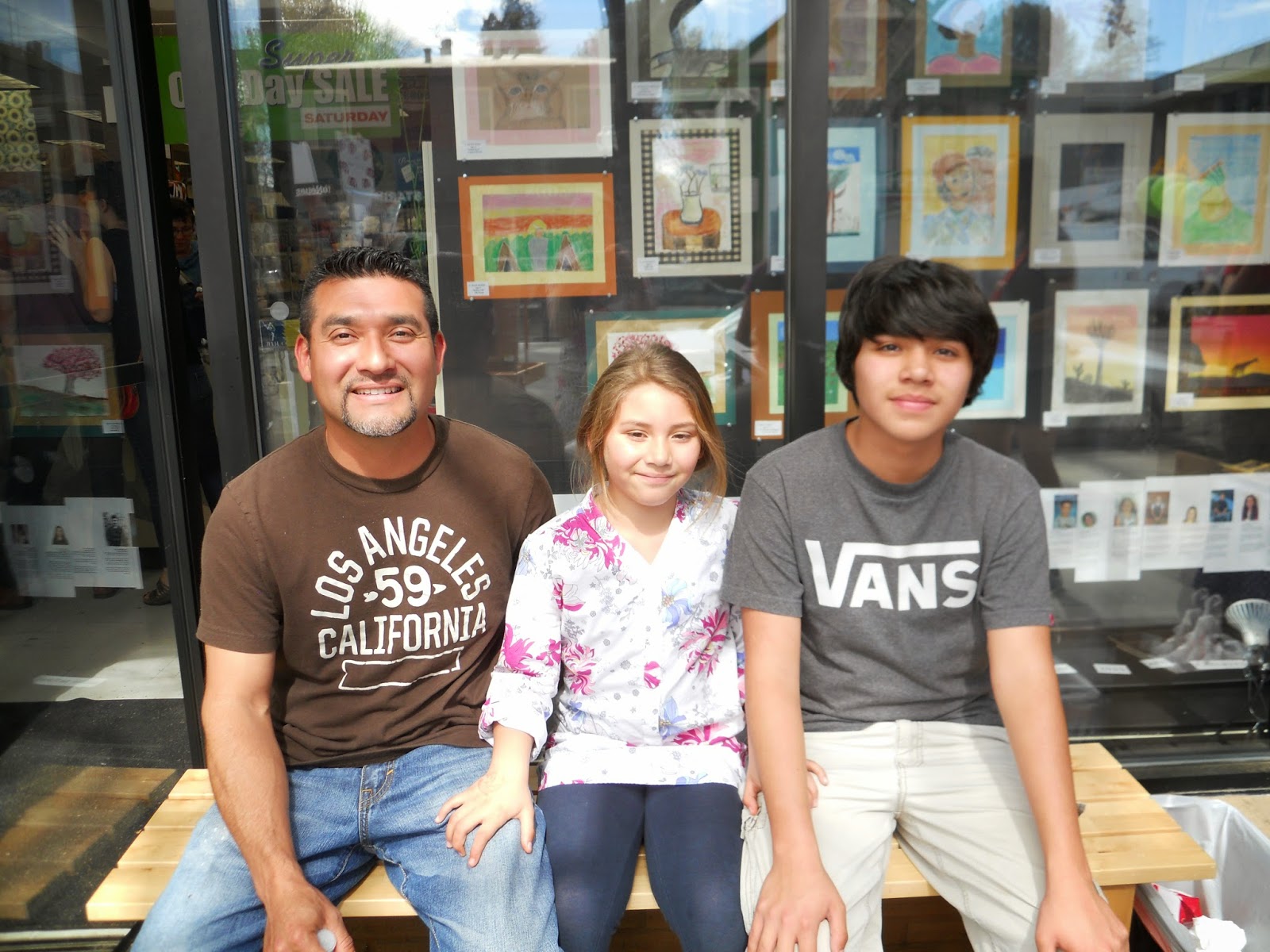 |
| Danielle, Edgar & their father |
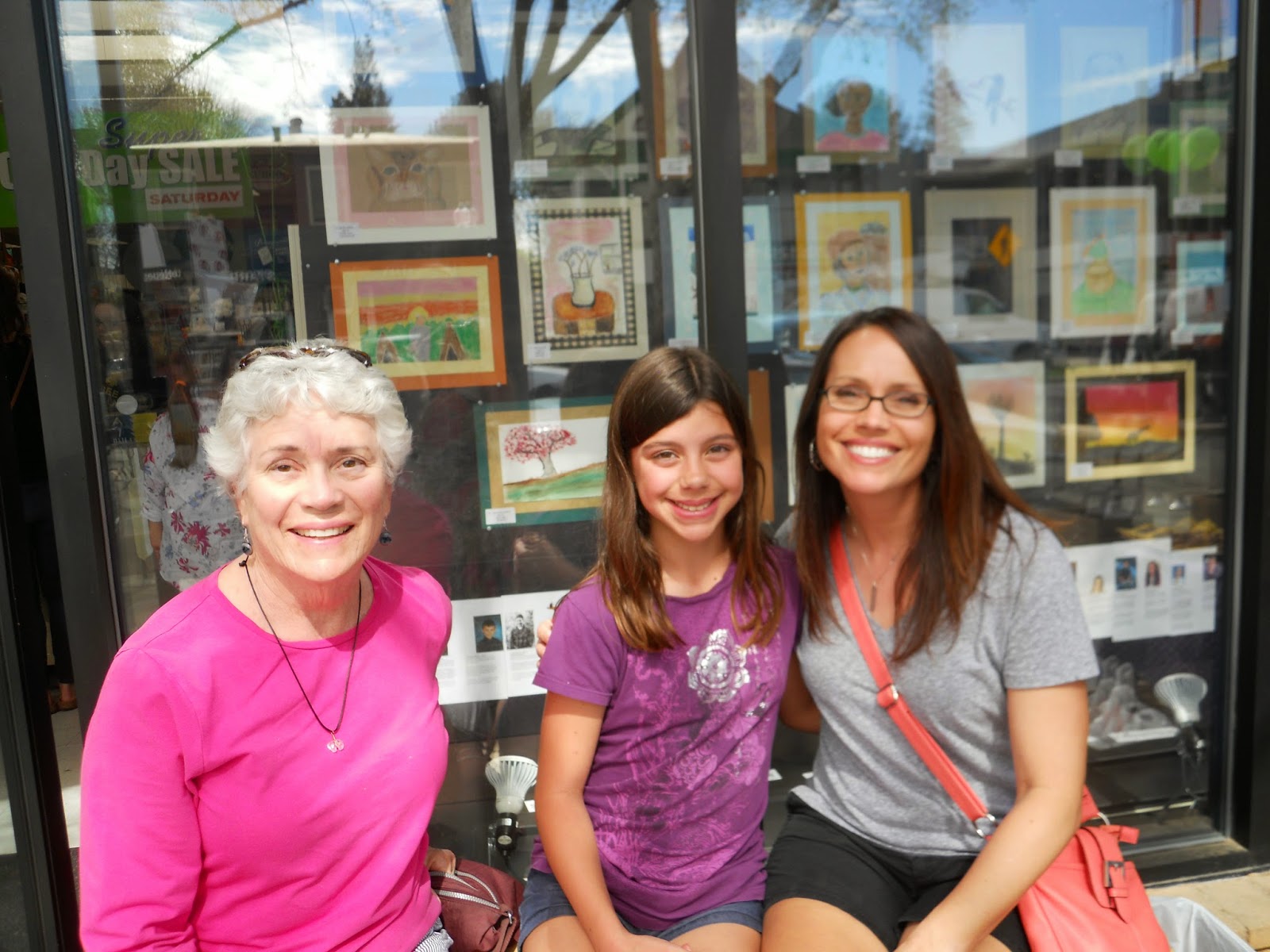 |
| Claire (center), mother & grandm. |
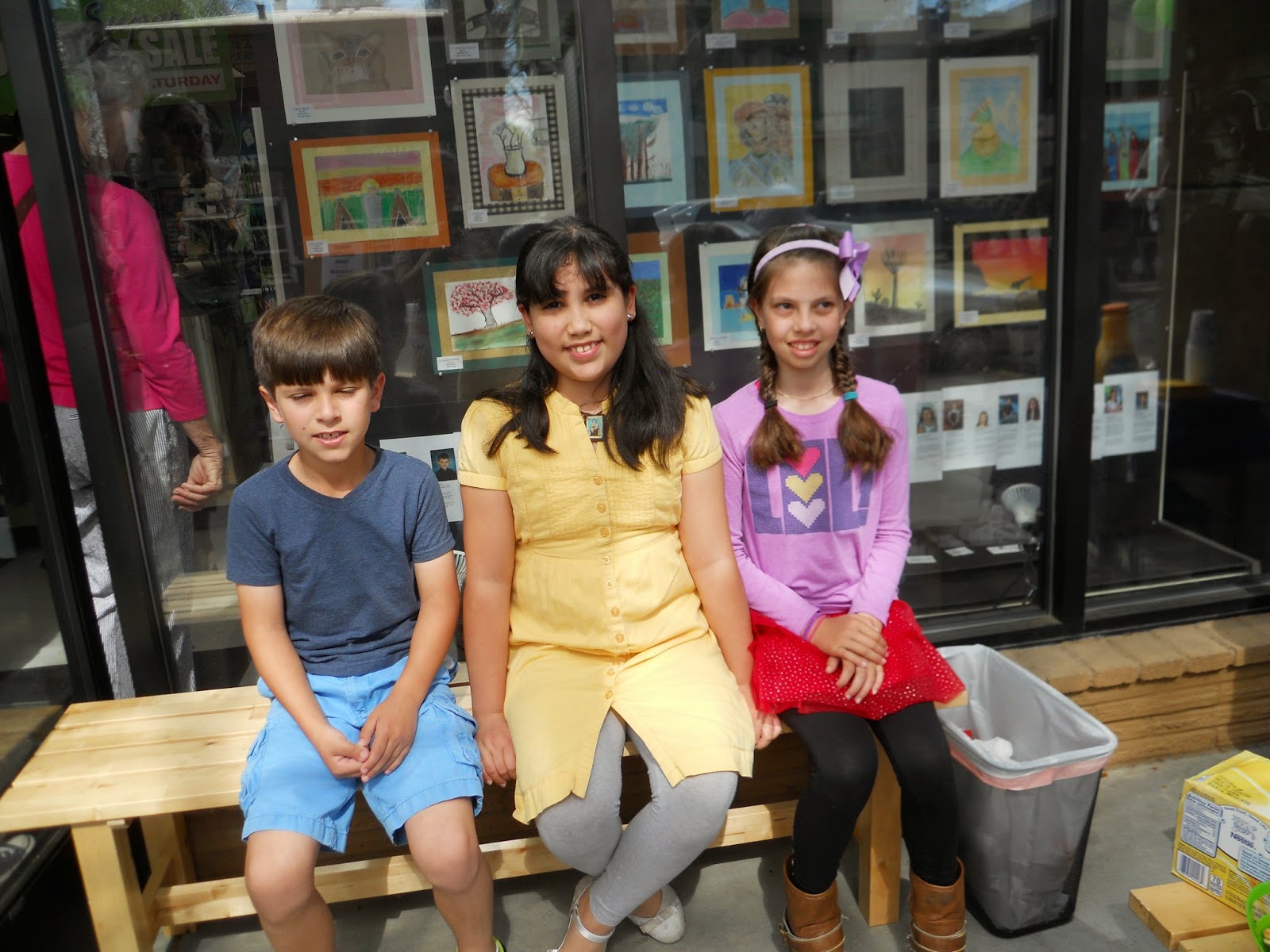 |
| Karla with sib & friend |
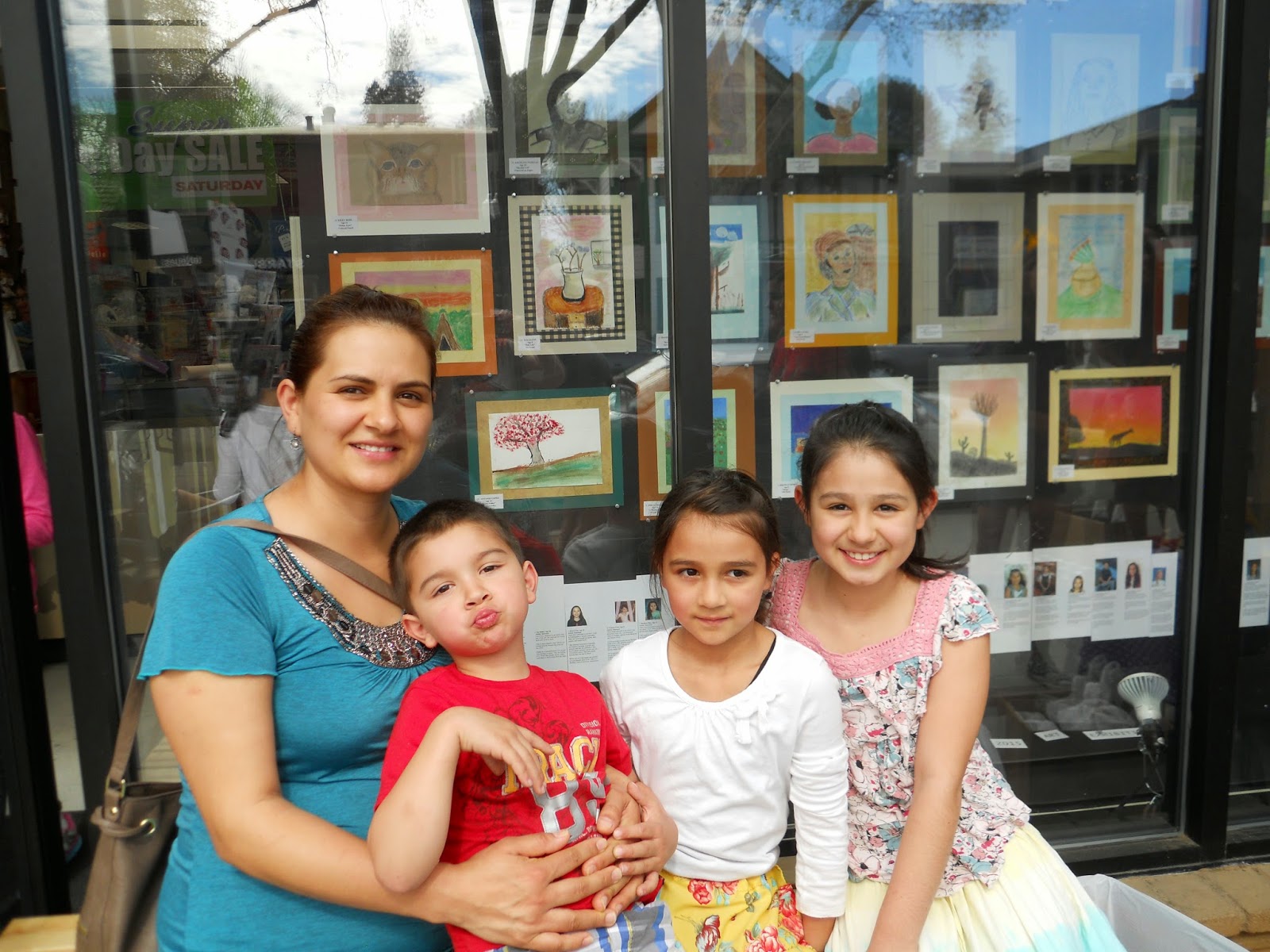 |
| Yaritza (right, w. mother & sibs. |
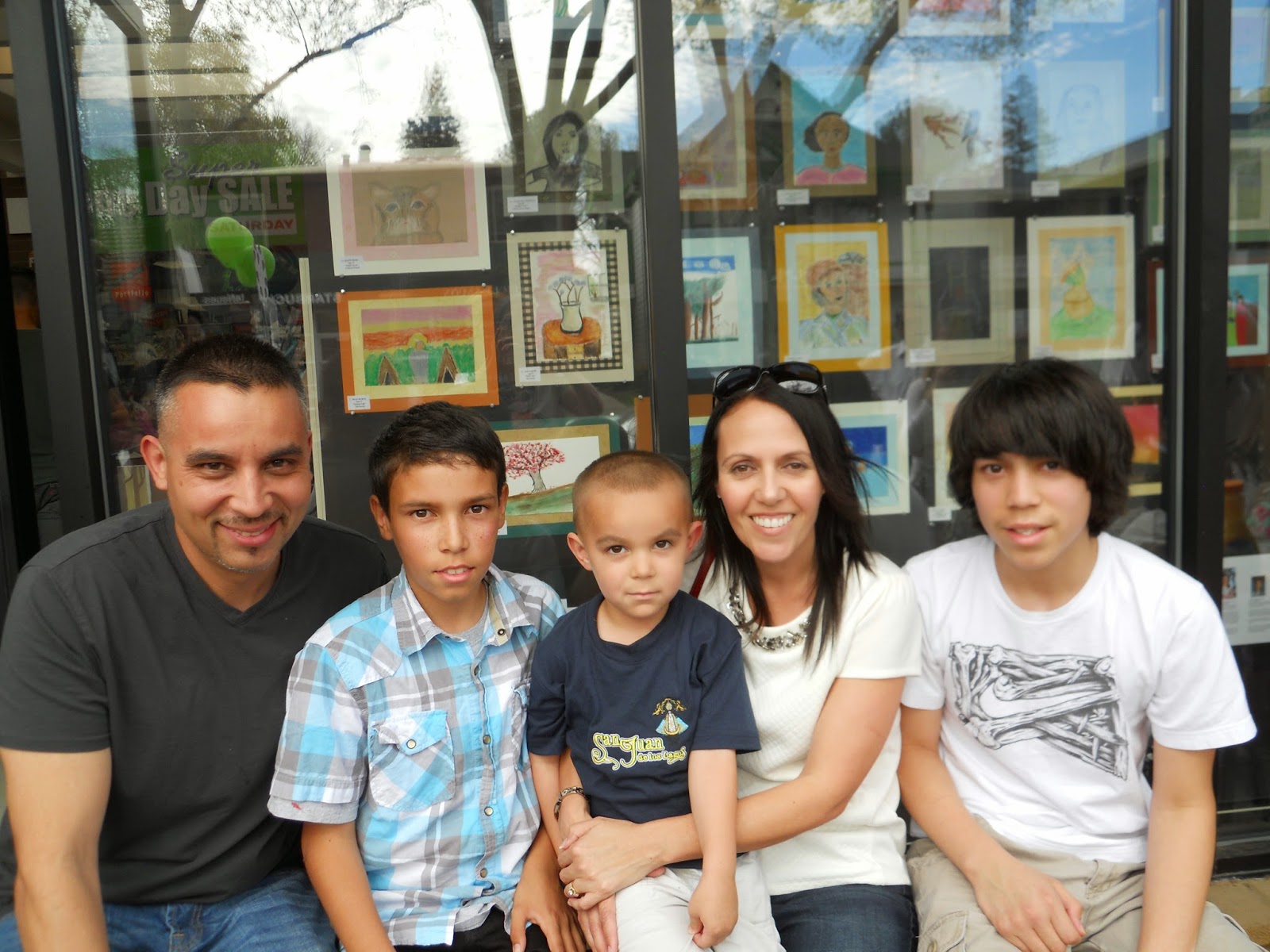 |
| Antonio (2nd fr. left) w. parents & sibs. |
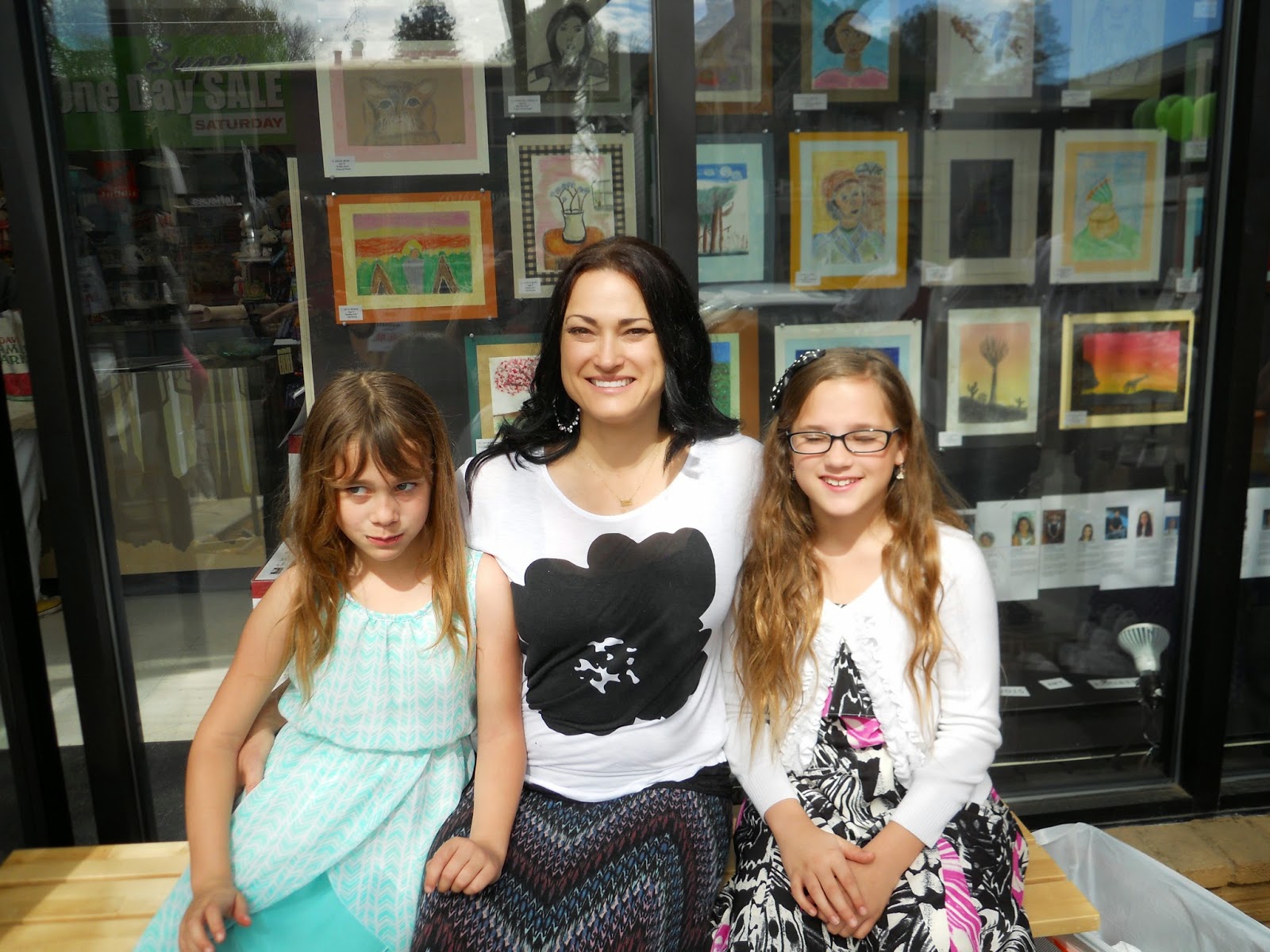 |
| Kailee (right), mother & sis |
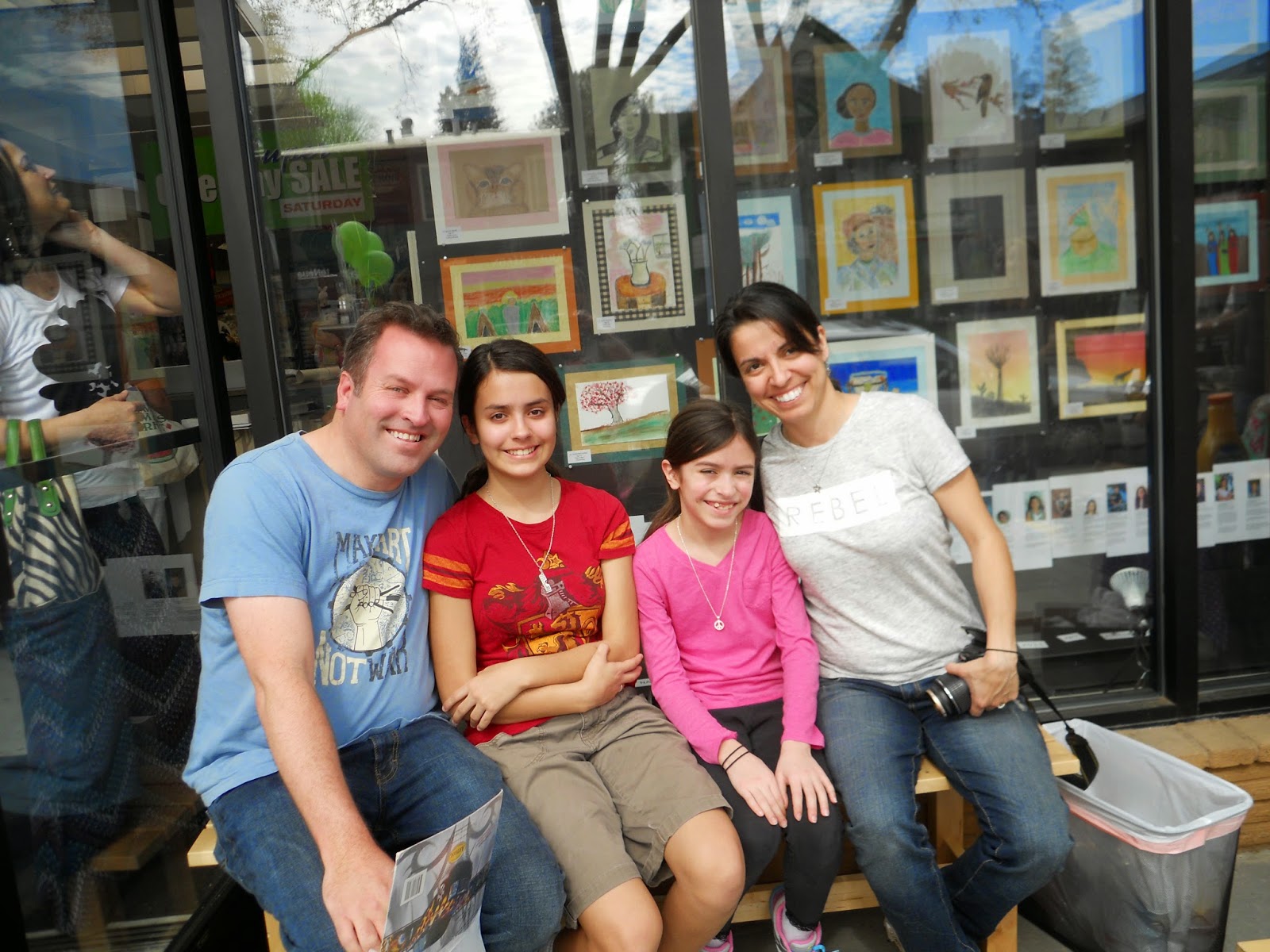 |
| Maya (in red), Ella ( in pink), parents |
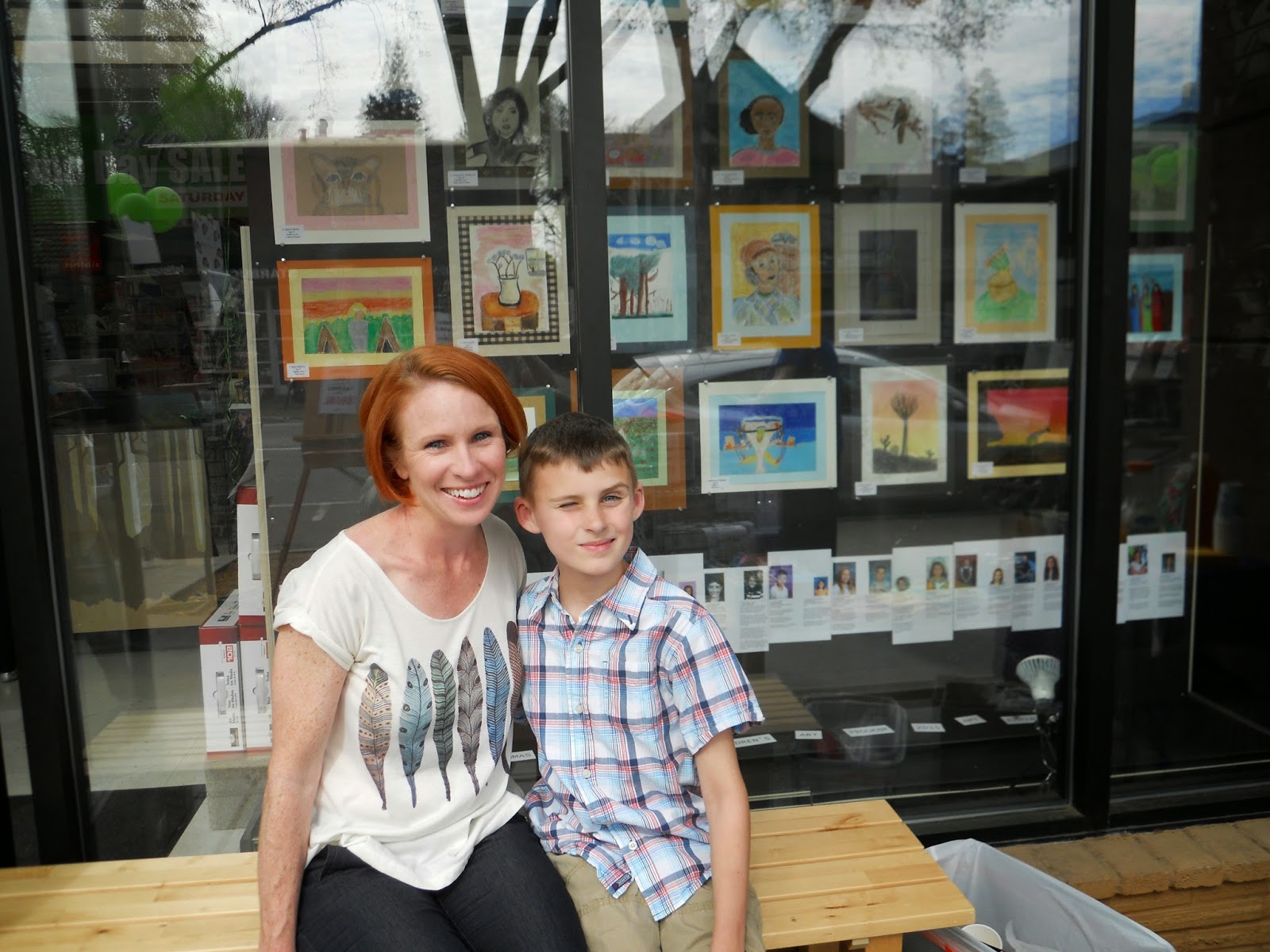 |
| Brennan and mother |
 |
Angeline (center), parents, sibs,
and grandmother |
 |
Savannah (center), mother (right), and
Emily (left) |
 |
| Miranda and mother |
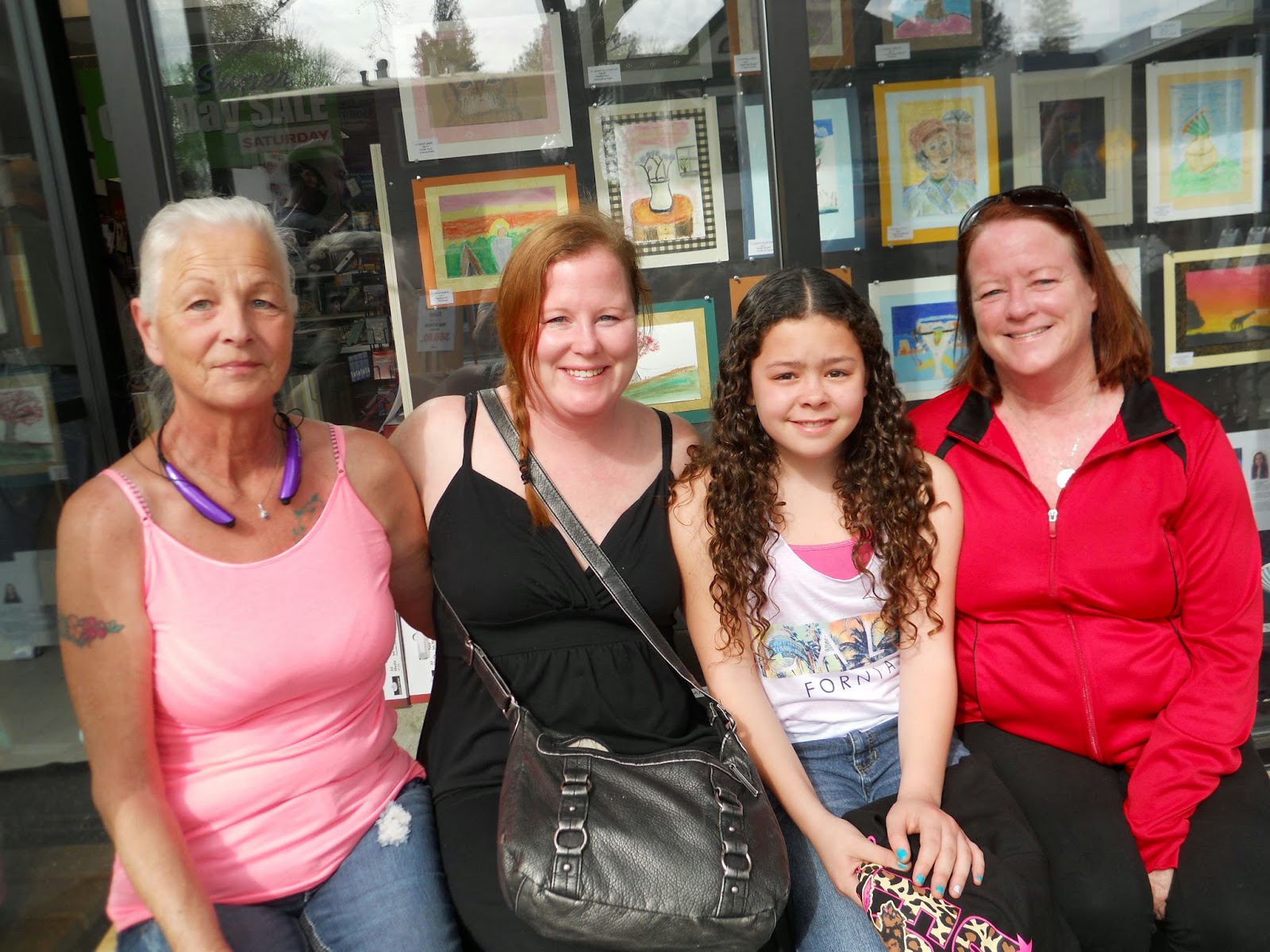 |
Madison (2nd from left) and mother
(next to her), grandmother & sib. |
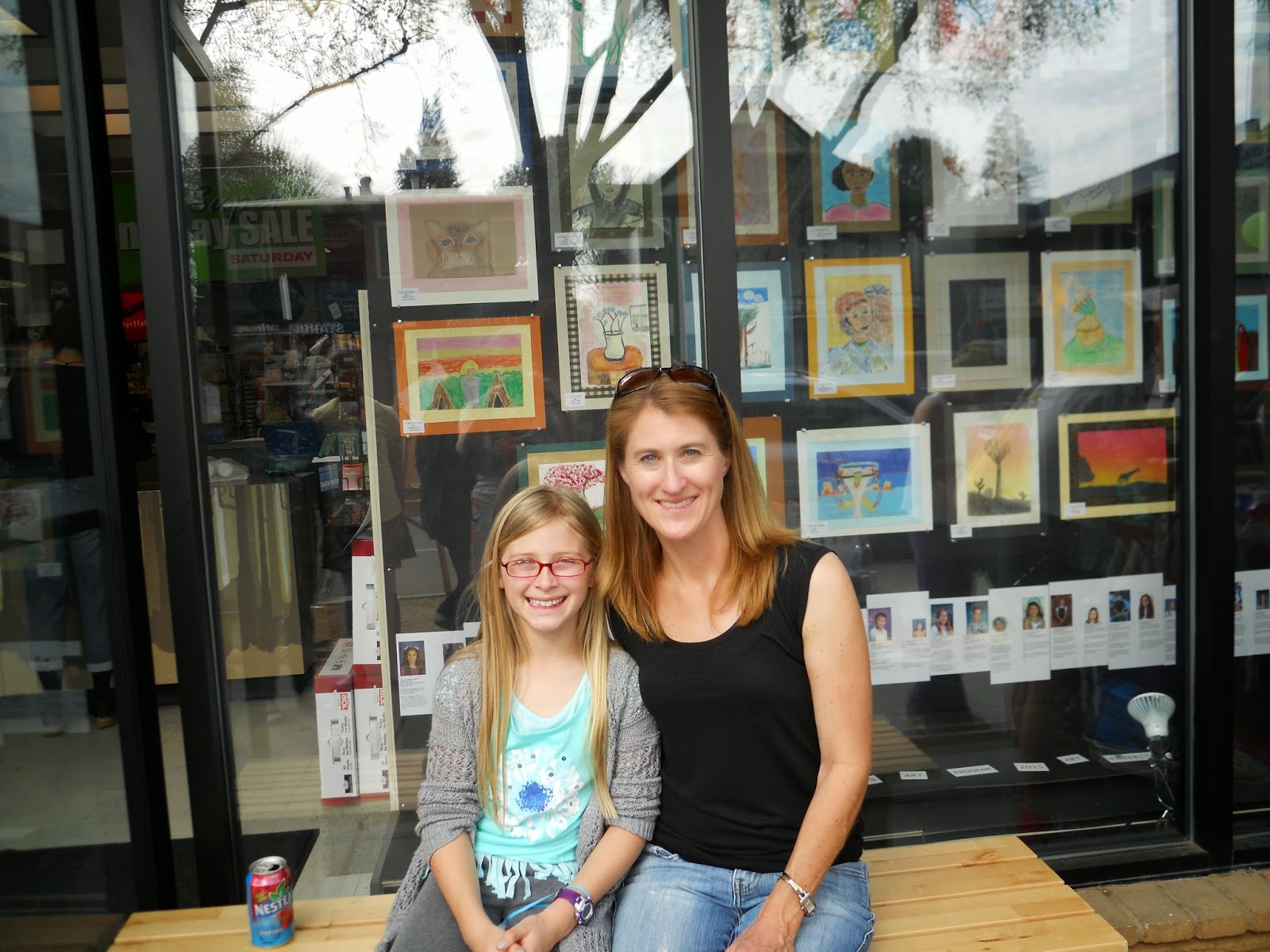 |
| Kiley and mother |
 |
Ian (left), sis, and father.
(Older sis, Kate, artist, was absent) |
 |
Erica (in red), Vanessa (in front of her),
mother (right) grandmother (left) and
youngest sister. |
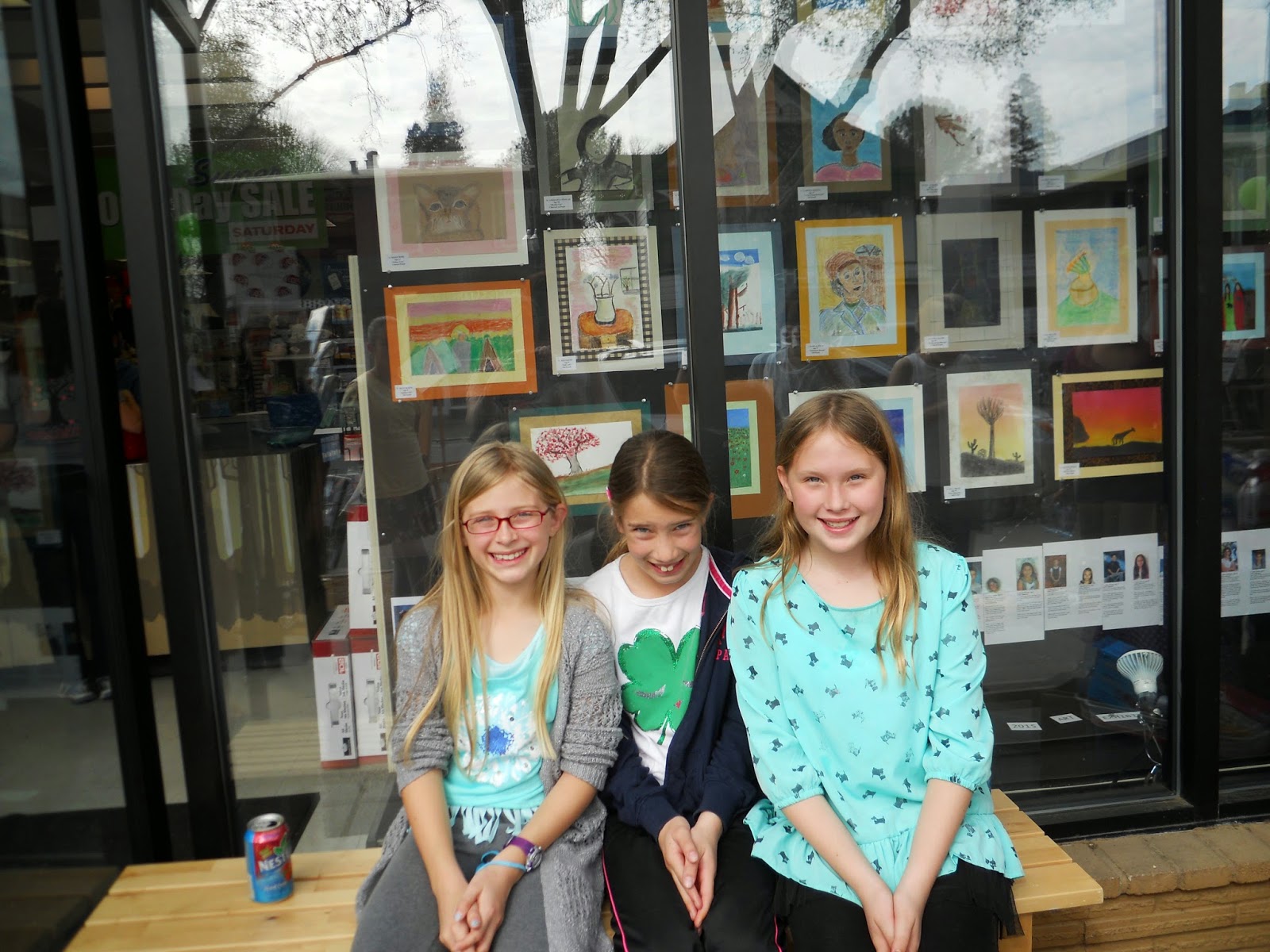 |
Kiley (left), Emma, (middle),
and Madison (right) |
 |
| Alyssa and father |
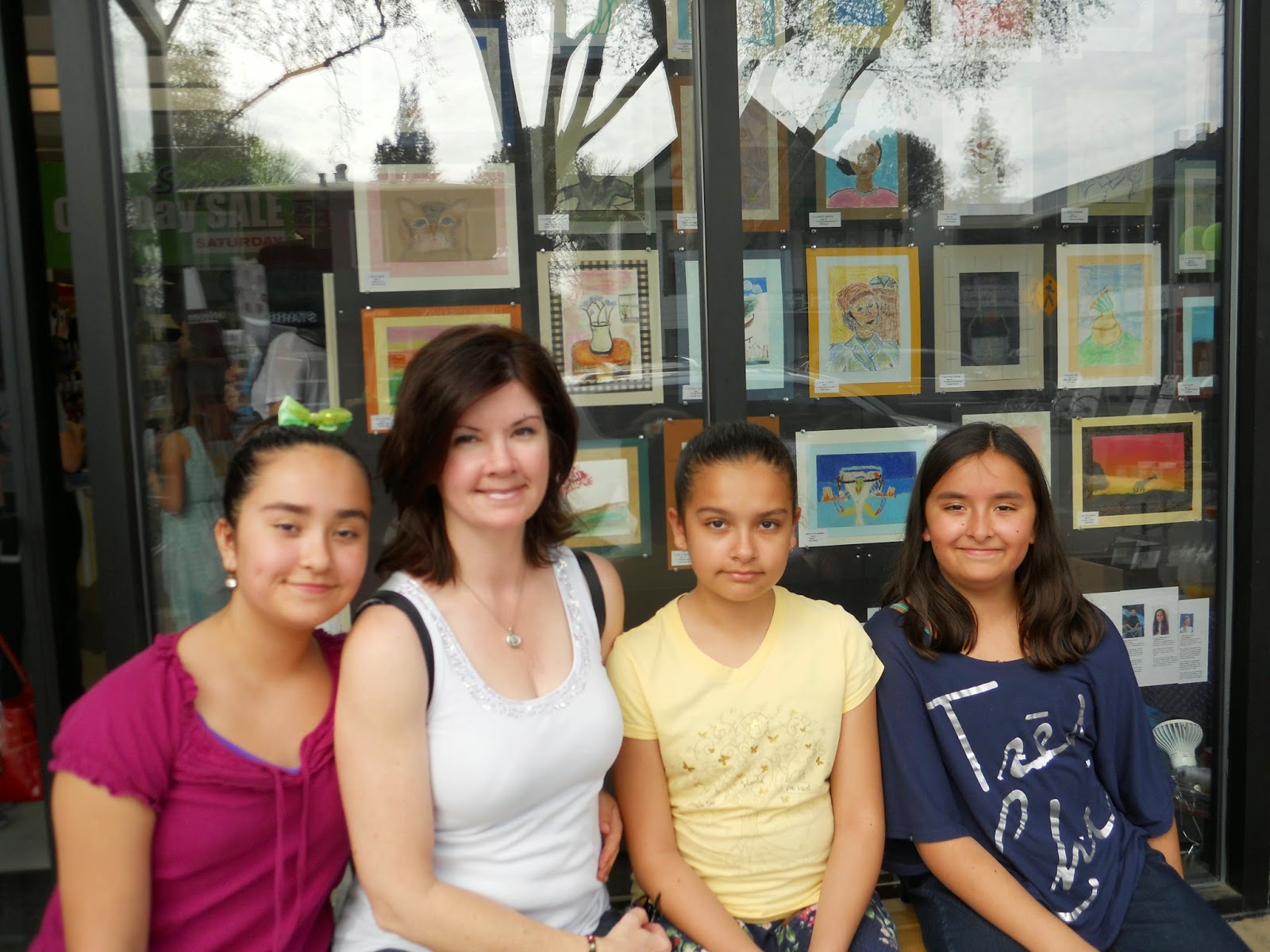 |
| Reina (right) sisters and mother |
 |
And that's it -- for another year.
|
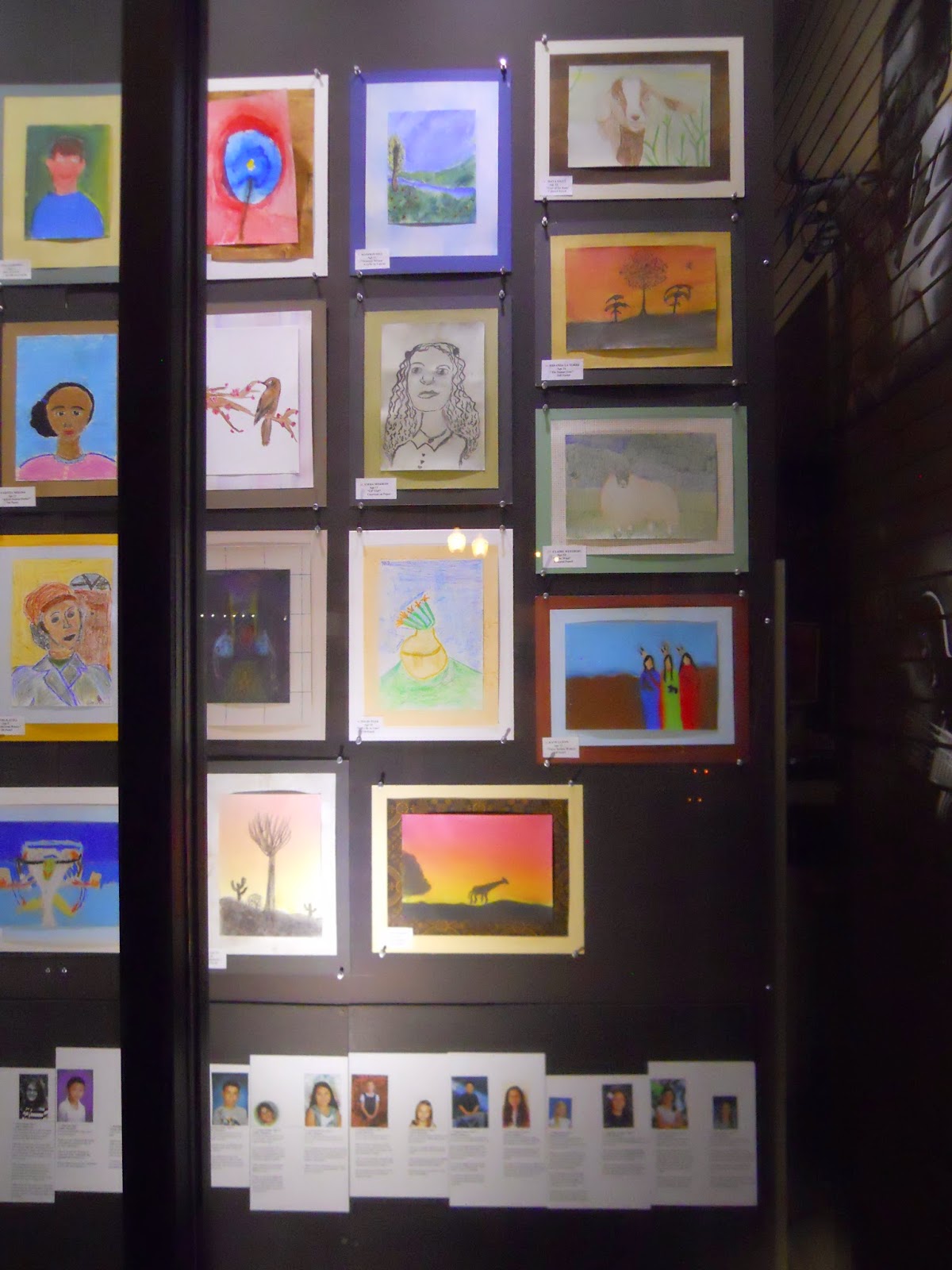 |
I hope you enjoyed
meeting them and
seeing their work. |

 |
This book is part of the
Writer's Digest Howdunit
Series. |
I mentioned in an earlier post that I’ve joined Sisters in Crime and the local chapter, Capitol Crimes. The local chapter meets monthly, and each month guest speakers share their expertise in either writing mysteries or being connected in some way to concerns of the mystery writer. One such concern is always whether a writer is presenting crime scenes or police procedures that are accurate. Last month we were fortunate to have Lee Lofland, the author of Police Procedure & Investigation, as our guest speaker, and he addressed those very concerns.
Lee Lofland is a former police detective, and the bad news is that much of what you see on your favorite crime show is misleading and/or inaccurate. His book, on the other hand, is a very thorough coverage of everything an author would want to ask their local police department. Blurbs by best-selling mystery writers (including two of my favorites, Rhys Bowen and Hallie Ephron) give his book high praise, and I was pleased to find that the writing – entertaining and sobering by turns – is always a good read. He presents facts that you really want to know in a way that don’t make your eyes glaze over. A few examples:
The difference between police officers and detectives; how they’re trained; what they do.
Arrest and search procedures.
The differences between homicide, murder, and manslaughter.
The difference between a crime scene and the scene of the crime.
DNA and fingerprinting
What can send you to prison and what can send you to jail.
A section on different drugs and the effects of each one.
Differences in weapons (with photos) and how they work
The book’s appendices include a glossary of terms, police 10 codes, a drug quantity table, and a federal sentencing table. It isn’t necessary to read this book straight through, chapter by chapter. There’s a thorough index that helps when you just want to look up something useful at that moment in your writing, along with good visual aids (charts, diagrams, photos of tools, etc.) throughout the book. This is a must read for any mystery writer who wants their police procedural scenes to ring with accuracy.
Lee also shared with us the Writers’ Police Academy, held in August in Appleton, Wisconsin. Yes, there really is such a thing. You can register now and have hands on experiences that will enhance your scenes. For more information about what is covered, check out their website
HERE .
Lee’s book is available in paperback and Kindle at Amazon
HERE .
You can contact the Lee Lowland at his website,
The Graveyard Shift, HERE, and learn even more about police work to enrich your mysteries from his frequent blog posts.
 |
| The author and friendly officer. |
 |
| A must have book. |

 |
| Book Three in the series |
I’m always looking for new mystery authors. (New to me, that is. Some of my discoveries have actually been publishing for awhile before I’ve discovered their books.) Last spring, when I attended a panel to listen to four mystery authors talk about their writing, one of the authors was Terry Shames. Since then, I’ve had the good fortune to get hooked on her Samuel Craddock series, based in a fictional small Texas town called Jarrett Creek.
I started with book one, A Killing at Cotton Hill, because I like to see how an author jump starts their series. I liked it so much that next I had to read The Last Death of Jack Harbin. I’ve just finished her third in the series, Dead Broke in Jarrett Creek (shown here), and I’m already looking forward to her fourth, A Deadly Affair at Bobtail Ridge, which comes out next month. But you don’t really have to read them in order to enjoy them. Each story is complete in itself and the author deftly slips in back story and characters' gossip and memories so that you feel like you know these people right away.
The main character, Samuel Craddock, a retired police chief, is a widower who lives on a small acreage at the edge of town, and has a kindly affection for his cows. He grew up in Jarrett Creek, but developed a taste for fine art through his deceased wife. As a result, he has an enviable art collection on his walls, a collection fraught with memory, since he and his wife purchased many of the paintings together.
Craddock is a an affable sleuth, full of homegrown wisdom and sterling character virtues. He can be firm when he needs to be, and while his manner is encouraging and disarming as he makes his enquiries, he doesn’t miss a thing. He often reflects on the other character’s lives, the locals he grew up with. His voice is so authentic, I can almost hear him when I read his narrative (which is in present tense, a tense that works very well in these mysteries).
The cluster of characters Samuel deals with are also three dimensional, with voices of their own, each one a memorable personality. To name a few: Loretta, Craddock’s neighbor and friend who brings him baked goods and gossip almost daily (and tries to pry out of him facts about the current case). Jenny, a lawyer and a good friend with whom Craddock dines out occasionally -- solely for companionship, as he is still grieving his wife.
And, of course, the current police chief, Rodell Skinner: self-important, lazy, spending more time at the bar than the police station. Because of Skinner’s alcohol problems, the townspeople have more confidence in Craddock than in him. Consequently, Samuel is the one they turn to when something goes wrong. In Dead Broke in Jarrett Creek, Skinner’s drying out, so once again Craddock has to solve the case.
The series is set in Jarrett Creek, a marvelously drawn small town with just the beginnings of suburbs. A few farms outside the town. A main street with family businesses. The local high school. The town hall. The café in town, called, appropriately, Town Café. The bank. The various churches. The town jail. I leave these books feeling I know this place. It feels familiar, as if I’ve been there personally, even though the place is a pure work of fiction.
Best of all, these plots are true puzzle mysteries, and Shames weaves the threads of clues back and forth with expertise. As Craddock ruminates on facts he unearths while interviewing people connected to the case, each person becomes a believable suspect until the very end. And the ending is always satisfying, evoking that combined response: “Huh? Oh. Of Course!”
I’ve posted the book cover of Dead Broke in Jarrett Creek, but you can find all of her books on Amazon HERE
Her Website is http://www.terryshames.com . If you hurry over and subscribe to her newsletter before Apri1 1, you have a chance to win a copy of A Deadly Affair at Bobtail Ridge.
You can also visit Terry Shames on Facebook HERE and follow her on Twitter HERE
 |
| Terry Shames |
 |
| Win a copy of this. |

I love a good mystery. So when Catriona McPherson -- current President of Sisters-in-Crime at the national level -- was speaker at the local chapter (Capitol Crimes), I was delighted. I was already hooked on her
Dandy Gilver series, featuring an aristocratic sleuth in 1920s Scotland.
But it’s one of McPherson’s stand alone contemporary mysteries, that recently grabbed me: As She Left It is a layered mystery that keeps unfolding in new surprises, just when you think you’ve figured it out.
In As She Left It, Opal Jones left her alcoholic mother when she was twelve to live with her father and step-family in Whitby. After her mother’s death, Opal finds the old home -- one half of a cottage on Mote Street in Leeds -- is now hers, and she moves back.
At first it seems the old neighborhood really is “as she left it” thirteen years ago. The Mote Street Boys in the corner house still play their gigs. Opal used to take trumpet lessons from one of them, Fishbo, who is so happy she's come back.
But Margaret Reid’s three-year-old grandson, Craig, disappeared ten years ago, on a Saturday, and the neighborhood has never recovered. And in the crooked foot posts of a bed delivered from an antique store, Opal finds secret messages that hint of a little girl's abuse many years ago.
When Opal sets herself to solve these two mysteries, she uncovers only more: Someone was paying the house bills after Opal’s mother died. Who? And why? Mrs. Pickess, the neighborhood gossip, provided brandy in large quantities to Opal’s alcoholic mother through the years. Why? On some nights, Opal hears a man crying in the other, rented half of the house. Who is he? What secret is Fishbo, her beloved old music teacher, hiding? And why does it start looking like little Craig disappeared on a Friday instead of a Saturday?
I was mesmerized by both the brilliant plot and the lovely writing. The characters, some of the most endearing you’ll meet in a mystery, are three dimensional. Opal is unforgettable, by turns brave and nervous, gullible and cynical, bitter and hopeful, and thoroughly believable.
And a picture in her head, the little lost boy and the little girl -- who sounded pretty lost to Opal -- had joined hands and were walking away into darkness, maybe going to be lost forever, unless Opal followed them and brought them home.
As She Left It -- winner of the 2014 Anthony Award for best paperback original -- is the kind of mystery you read more than once.
To learn more about McPherson's books, see her Amazon page HERE or visit her website HERE You can also contact her on Facebook
HERE
What kind of mysteries do you prefer? Series or stand alone? Cozies or psychological?

The long silence since my Christmas
 posting was due to the exciting news that my middle grade mystery, Imogene and the Case of the Missing Pearls, will be published in June by MX Publishing. I was busy with formatting and editing issues to get it ready. (MX Publishing specializes in Sherlock related books, so Sherlock fans can go HERE to see a wonderful selection.) You can also read more about my book next door on my Victorian Scribbles blog HERE:
posting was due to the exciting news that my middle grade mystery, Imogene and the Case of the Missing Pearls, will be published in June by MX Publishing. I was busy with formatting and editing issues to get it ready. (MX Publishing specializes in Sherlock related books, so Sherlock fans can go HERE to see a wonderful selection.) You can also read more about my book next door on my Victorian Scribbles blog HERE:
Not surprisingly, I have been reading a lot of mysteries both for young people and for adults. I recently joined Capitol Crimes, the local chapter of Sisters-in-Crime, since I'm currently working on a cosy mystery for adults. I was invited there by a friend, and it's her book I want to talk about today: Flint House, by Kathleen L. Asay, published by Bridle Path Press.
Flint House is a mystery, in fact a bundle of mysteries revolving

around what happens when disparate lives intersect over what should be a tragic event and stir up past events each character would like to forget.
Liz Cane, a cynical journalist with
The Sacramentan, goes for an interview with Maisie Flint, the unpleasant owner of Flint House, a Victorian landmark in town. At one point, Maisie interrupts the interview to check on something upstairs. A few minutes later she tumbles down the stairs and dies.
Did she trip? Or was she pushed?
The tenants of Flint House are life's strays, hiding out from life in this rickety, shabby old Victorian. One mysterious tenant is called The Princess. No one knows her real name, but all the tenants seem to adore her, whereas none of them were especially fond of Maisie. The tenants also face eviction once Maisie's distant relative shows up to claim the house. The Princess claims to have a solution that will save Flint House. Then she is found in an alley, beaten nearly to death.
A random attack by a stranger? Or was she attacked by someone who knew her?
Despite herself, Liz gets drawn into their lives. She finds herself pursuing the story, partly as hard-bitten reporter, and partly because she cares about this motley collection of people who have become a family to each other. She's also obsessed with solving the mystery of The Princess's real identity.
I know it's almost a cliche these days to say "I couldn't put the book down," but I couldn't. It was an engrossing read, and the characters are memorable. Despite the events I've mentioned, it's also a heartwarming read. I highly recommend it.
And no spoilers here. You will have to read the book to answer the questions raised above.
You can buy the book
HERE: and
HERE:You contact the author at her website
HERE:
 |
German soldiers of the 134th Saxon Regiment pose with men of the Royal Warwickshire Regiment in 'No Man's Land' on the Western Front, in December 2014. Photo is in Public Domain
Taken from an article HERE |
Twice, now, I’ve blogged at this time of year about Joyeux Noel, a 2005 film that was nominated for both an Academy Award and a Golden Globe Award for Best Foreign Film. The individual stories highlighted were fictitious, but the overall story is based on a true happening on a Christmas Eve in 1914, in the theater of war: Scottish, French, and German troops agreed to a cease fire and put down their weapons to celebrate Christmas Eve, even warning each other of planned shellings the next day and offering refuge in each other's trenches when the shellings occurred.
For all three military groups, the only thing that saved troops from being tried for treason was the fact that 200 or so in each case would have to be tried. Instead, all the participants were transferred to other fronts to make sure it wouldn't happen again. It was a remarkable film, and a story I won't forget.
I was reminded of it again when the Sacramento Bee published an article in Saturday’s paper about this phenomenon, a phenomenon that occurred in several places across Belgium and across the Western Front.
In Flanders Field, the site of John McCrae’s famous poem comparing slain British warriors, German soldiers began playing music familiar to both German and British soldiers. Soon an informal truce was struck. Troops visited each other, gave each other food and even small gifts. Some played games. For a little while, Peace broke out. And then, as in the movie above, army generals made sure it would not happen again. In the following war years at Christmastime they stepped up the fighting to ensure noone would even think of a truce.
So here it is again, the New Year approaching, and the Christmas message hovering still.
Best wishes for the coming year, and for a time of peace, when people can be forgive the atrocities of war and unite again in their common humanity.

 |
| My writing corner when it's tidy. |
 |
| Although this is what is usually looks like. |
Hello, again, at last, after the long silence. I have keenly missed blogging and connecting with blog friends, but I had to put writing first these last few weeks, and it's paid off. I finished my mystery, and now I'm doing the re-thinking, re-conceiving, additional research, etc. that is so much of the re-writing process. And I have been reading a wonderful book that I just have to share.
The Art of Character, by David Corbett.
I first came across Corbett's insights in an article titled, "Characters, Scene by Scene", in the January, 2015 issue of
Writer's Digest. (Yes, I know it's not January yet, but that's how magazines do things.)
In his article, Corbett emphasizes that
"dimensional characters are born from drama—not description." Yes, you should know descriptive and biographical details: eye color, hair color, height, weight, hobbies, work history, biographical information, etc., but that's doesn't create characters who live and breathe. What brings them alive on the page is interaction with others in scenes that serve a purpose in the story.
To paraphrase just one of his examples: How your character looks isn't as important as, say, how her appearance makes her feel, how it makes others feel, and how this translates into behavior. The same is true of age: How does her age affect her interactions? I have to say that just reading this article inspired several insights into my main character and a couple of others, and I immediately sent off for his book,
The Art of Character. Here's the book at Amazon, although several sites sell it.
And I bought the paperback, not the kindle. (When I read something this pithy, I do a lot of underlining.)
The Art of Character does not disappoint. It's like a course in creative writing, with exercises that are challenging but oh-so useful if you want rounded out characters that truly drive your story. It's also like a course in psychology, probing your characters fears, desires, hates, loves, spirituality or lack of it. Or a course in sociology. Or philosophy. Or literature. (Corbett gives solid examples of stories, plays, novels, that illustrate the concepts he covers.)
You can tap into this book as deeply as you feel your work calls for, but the advice and insights gleaned from it are useful for any genre: light fiction, cosy mystery, MG or YA novel, literary adult fiction. It's the best book on writing I've come across in a long time. And it's the kind of book you can return to again and again.
You can visit his
website to learn more about this book and the best-selling mysteries he writes. Meanwhile, I have to get back to the last chapter, the one on "voice". Happy reading.
And happy writing.

 |
One of the most interesting bookshops ever: Centésima Página
on Avenida Central in Braga. That's me, there, wishing I
could read Portuguese, a beautiful but challenging language. |
 |
| A delightful café bar called Copa. Again, in Braga, Portugal. |
Hi, Friends,
I have not been posting because I've been working hard at finishing my book. Almost there, too. I have two more chapters that I'm determined to finish this week before we head home.
Next week I'll be posting again, and when I take writing breaks, I'll be visiting and reading your blogs, as so many of them inspire me. Meanwhile, I leave you with two pictures above from Braga, Portugal. Once we are home, I'll be writing more about that trip as well as bits and pieces about Galicia.
Hasta entonces . . .


By:
Elizabeth Varadan,
on 10/6/2014
Blog:
Elizabeth Varadan's Fourth Wish
(
Login to Add to MyJacketFlap)
JacketFlap tags:
pulpo,
olive oil,
Galicia,
Monforte,
feria,
fresh bread,
house wine,
pimiento.,
Spain,
Add a tag
 |
A plate full of pulpo. You eat it with
toothpicks, bite by bite. Then you
break off chunks of crusty bread and
sop up the spiced olive oil. Yum! |
 |
Our wonderful neighbor,
Miguel |
Today, despite the fact that it's nearly two weeks since our return from Portugal, I had every intention of writing a post about
Fado, the Portuguese art form of song we both love so much, to be followed by a later post mid-week about the photography festival we attended when we were in Braga Portugal.
But then our neighbor across the lane from us treated us to
pulpo at the
feria in Monforte, 20 minutes away from our village, and, as usual, we were enthusiastically swept away. (This is the neighbor who keeps sheep, and sometimes in the mornings, we awaken to their soft bleating.) Off we went, my Fado post tabled for another day.
Pulpo is octupus, boiled, cut in small pieces, drizzled with olive oil and sprinkled with salt and
pimiento - which in this area, means hot red pepper. All of our neighbors simply love
pulpo, and their enthusiasm has been contagious. Though vegetarians, we do eat
pescados and
mariscos (fish and seafood), but octopus was a new experience for us. When done right, meaning boiled long enough, it comes out moist and tender and just delicious. It is served at long tables, in special buildings at all the fair grounds, and one of the servers comes around with a bottle of the house red wine and a loaf of fresh bread to go with it.
 |
The woman boiling this pulpo
is the neighbor of a woman in
Turiz, Melucha, whom we met
years ago when she was walking
her cows down the road to graze.
The people in these neighboring
villages all know each other, so
Miguel was able to tell us this. |
 |
Rajan, adding his touch. We
actually see this woman and
another (who is distantly re-
lated to Miguel), at ferias in
the other villages, since the
market days in the villages
fall on different days. |
 |
One of the long tables set up for this
event. For those who don't like pulpo,
there is also barbequed beef or sausage. |
 |
Despite the note about beef, most of
these people are eating pulpo,
always the favorite. |
 |
| Good to the last drop. |
 |
| Definitely a satisfied customer. |
Feria is "fair" or market day, and in the mornings, nearly everything is sold at a
feria: shoes, blouses, scarves, belts, beaded jewelry, plants, fruit, all kinds of produce, honey, bread loaves of all types, utensils for making wine, utensils for making the home-made brandy so popular here,
aguardiente. One shot of that will blow your head off, but most people around here confine it to a little shot in their coffee when they do decide to have it. There is also a special drink they make, using
aguardiente, called
quemada, with orange peel, apple peel, coffee beans, and sugar, blogged about, before
, HERE. (Scroll down to the very bottom of it, and you'll learn about the drink and the history behind it, as well as seeing the clay vessel they make it in and the clay cups they serve it in; the set is also called a
quemada, and it is also sold at the
ferias.)
While we were there, a gypsy playing an accordion came in and played some melodies that were so familiar to the crowd, some sang along. It was an absolutely charming touch (and he gained a few coins for that) but, alas, I didn't take pictures. A memorable lunch, for sure.
How about you? Have you ever eaten octopus? Have you ever found yourself eating a dish you thought you never would?

 |
Inspiring Blogger Award from
Julia Hones |
 |
Liebster Award from Sandra Cox
See below the info that comes with
the Inspiring Blogger Award |
First the apologies for not blogging.
1.) I've been busy working on my mystery. My goal is to finish this draft by mid-September. There's 24-25 chapters in mind, and I'm on chapter 17 so far.
2.) We've had company and made a couple of out-of-town trips to visit folks we hadn't seen for a long time, due to travels.
And 3.) We are getting ready for another long trip to Spain and Portugal. (I haven't even finished blogging about the last trip, but that's how it goes sometimes. Oh, the stories I'd like to tell!)
Meanwhile, two very nice blog friends gave me awards that you can see at the top of this page and read about below. Thank you so much, ladies!
Julia Hones gave me the
Inspiring Blogger Award, which I find quite an honor. Julia has a marvelous blog called
My Writing Life that I love to read and find inspiring in its own right, and you will too, so do check it out. She's also had many short stories and poems published and is the poetry editor of
Southern Pacific Review.
As a recipient of the award, I'm supposed to reveal 7 things about myself and then pass the award on to others whose blogs I find inspiring. Hmm. 7 reveals . . . Okay, here we go.
1. In my junior year in college, after finals, I let a girlfriend talk me into bleaching my hair blonde. (She was bleaching her hair, and we were hyper from finals, so I thought, "Why not?") Because I have a lot of red in my hair, it went red instead of blonde. Because I have a few freckles, everyone who met me as a redhead thought I really was a redhead -- to the point that when I got tired of it and decided to dye it back to dark brown, I was told, "No, don't do that, it won't look natural."
2. My favorite dessert is a cookie. Forget pies, cakes, and rich creamy custards. Give me a cookie. Any cookie, although I like sugar, shortbread, oatmeal, or peanutbutter the best.
3. I am a crossword puzzle nut. I love the New York Times crossword puzzle. I can't always finish it (Fridays and Saturdays), but I usually start the day with it. For one thing, it wakes me up and gets the wheels turning for writing later in the day.
4. My husband and I met through a cat named Meathead. That is a ve-r-r-r-y long story, that only some of our friends know and would take up too much space here. But we have very fond feelings for our feline cat-alyst from long ago.
5. I used to write everything in longhand first, but the computer has spoiled me. Cut and paste is so convenient. Even so, I miss that feeling of connection between pen or pencil and heart, and I still write my poetry first in longhand.
6. This is probably a horrible confession for an author to make, particularly one who writes children's books, but . . . I never liked The Wind in the Willows. I know, I know, one of the world's great classics. What's wrong with me! But I never could get into it, no matter how many times I tried.
7. I loved Edith Nesbit and Edgar Eavers, though. And they stand the test of time. I re-read a couple of their books recently and still found them so funny.
And now the nominees:
1. Keith Wynne has a truly inspiring blog called Musings of an Unapologetic Dreamer . He'll also send a little blurb via email called Thought of the Day, if you sign up for it at his site. I bookmark nearly everyone of these blurbs, as they are quite pithy and inspiring.
2. Catherine Ensley is an author of inspirational romance novels and is writing a four-part series. On her blog she "shares her thoughts on country life, simple living, adventure, reading, writing and faith that transforms." I think you will find it very enjoyable.
3. Victoria Lindstrom's Writ of Whimsy blog is rich with Middle Grage book reviews, poetry tidbits, thoughts on writing, and a section I love, "Whimsical Word of the Week." Check out her site; it's great fun.
4. Lynda Young has a wonderful blog called W.I.P. It: an Author's Journey in which she addresses many issues for writers with insights and reminders that are so helpful to all of us on this common journey.
5. Check out Carol Riggs, a published YA author with a personable writing style. Her blog, Artzicarol Ramblings, is full of writing tips, YA book reviews, and shares of her own personal journey with agents and publishers.
6. Renee Hand's The Crypto-Capers Review is a children's book review blog as well as a platform for her radio show, Stories from Unknown Authors. Renee also writes winning interactive mysteries. How cool is that? Check out her site, and you may find yourself being interviewed if you've written a children's book.
7. Mark Noce has a rather eclectic blog, sharing news about his flash fiction publications, gardening, music he likes, and news about other writers. It's always a feel-good experience to read one of his posts.
On to the Liebster Award, which Sandra Cox kindly gave to me. Sandra's blog is called, not surprisingly, Sandra's Blog . Sandra is a prolific blogger as well as a prolific author. Spend a little time at her site. Her pictures will make you smile. Meanwhile, the Liebster Award is given to bloggers with less than 200 followers, ferreting out blogs you think are worthy of more followers. (Thank you, Sandra!) The rules for accepting the award are to share 11 random facts about myself, answer 11 questions posed by the blogger who nominated me, nominate 11 bloggers who qualify, and pose 11 questions to them. Happily, Sandra modified the rules, asking 6 questions, and nominating 5 newbies. So I am following her lead:
The questions she asked:1. If you were an animal, what would you be? Probably a dog. I love animals, but dogs have a special place in my heart. They are so loving and loyal.2. What is your favorite genre? That's a hard one. Mysteries and historical novels are about equal.3. When reading, do you prefer paper or a hand held device? Paper, for sure!4. What's your favorite vacation spot? Galicia, Spain. 5. What's your favorite charity? Another hard one. We contribute to a number. I suppose Southern Poverty Law Center, a remarkable organization that goes after hate groups in this country and prosecutes hate crimes.6. If given the choice, where would you live? Right where we live now. As a runner up, Galicia would be next, but we are quite happy where we are.
Okay, my nominees are:Richard Hughes at Writing and Living by Richard P. Hughes , is an eclectic blogger, sharing thoughts about writing, art, life in general, publishing issues. Right now he's running an interesting series of interviews with other bloggers, called, "Where I Live and Why I Like It.
Rosi Hollinbeck at The Write Stuff reviews children's books, interviews authors, and does a wonderful job of culling and sharing links to help writers in every sphere of writing. I always look forward to her posts, and you will too.Kenda Turner at Words and Such post book reviews, interviews, and shares rich thoughts about the writer's journey. Always a good read.
Loretta Proctor at Books and Other Things blogs about books, art, and music, "and all things creative and beautiful." Her current post is about Seamus Heaney, one of my favorite poets.
Jeanmarie Anaya's delightful blog, Jeanmarie Anaya is definitely worth your while. Humorous, pithy, eloquent. She writes about a number of writing issues, and wrote a lovely tribute to Robin Williams.
And here are my six questions for these worthy recipients:1. Where is your favorite place to read a book?2. When beginning a new W.I.P., do you write by hand or wordprocess?3. What are three of your favorite books? 4. If you could be a character in a novel you've read, who would you be?5. Which author, living or dead, do you wish you had the opportunity to meet?6. When did you begin to write for yourself (as opposed to doing early homework assignments)?
And that's it, folks. I look forward to your comments, (feel free to answer any of the questions I posed for the nominees), and I do hope you check out the blogs in both sections of this post.
Ciao for now . . . 
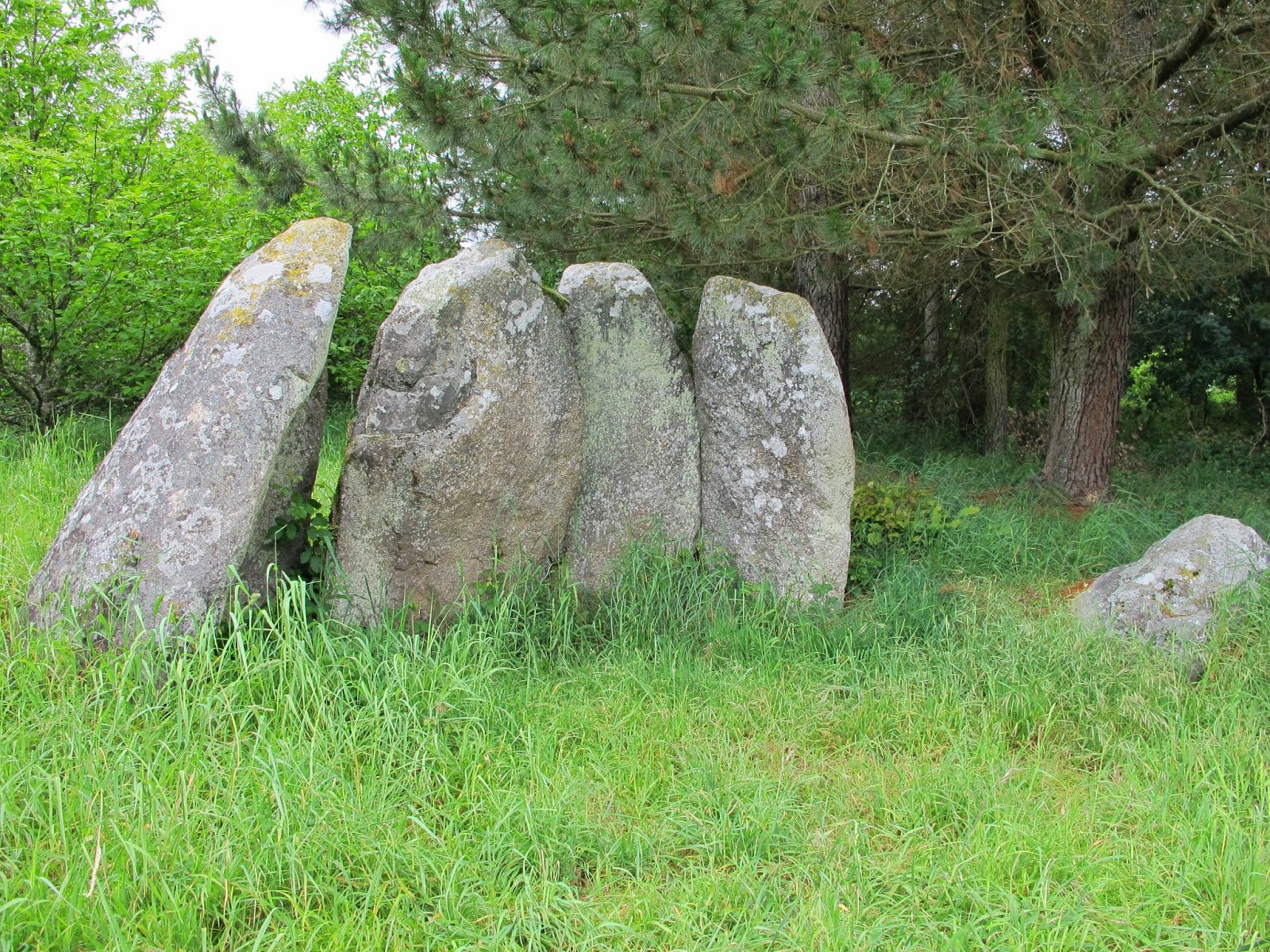 |
| Five big rocks that may surprise you. |
Here it stands, a collection four immense standing stones, the fifth one fallen to the side, tucked back in the far end of a field nearly hidden by trees, easily missed, if you didn't know about it. We knew about it because good friends in Galicia, Craig and Melanie, told us about it.
 |
Craig, Melanie, and their
loveable dog, Slawit |
A brief introduction here: Craig and Melanie are good friends in Galicia who sold us our house in Trasulfe.
They are from England, but they have lived in Galicia for about ten years, and Craig has written a book about their adventures. He also has a blog, and he wrote nice a post about the dolmen
HERE . Enjoyment of wine in Spain is contagious, and he has started growing his own vines and making his own wine (which is pretty good; we get to sample it whenever we go to Galicia. ) In addition, they have restored another home, and this one they rent out. (You can learn more about it at his blog site.)
So, back to the dolmen. And what is a dolmen? you might ask? Wikipedia gives a pretty good explanation of dolmens and where they can be found,
HERE . Basically a dolmen is considered a megalithic tomb. Usually it has
a flat capstone on top of the standing stones. Rajan and I wonder if the stone in the picture above that is off to the right is the original capstone for this dolmen. Originally dolmens were covered up with earth mounds, and 5,000 to 6,000 years of erosion have uncovered them.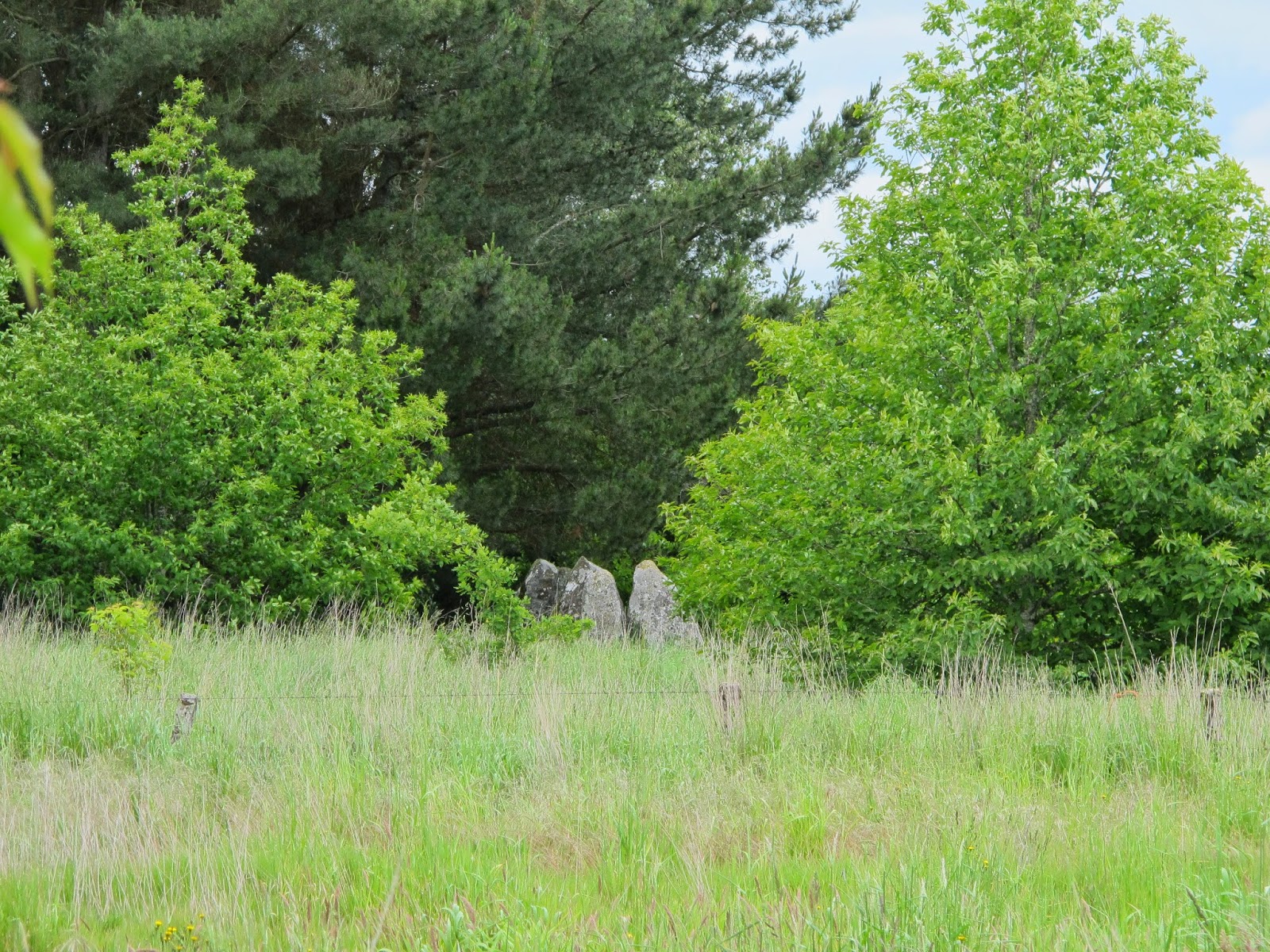 |
Even with enlarged photo, it's hard to tell. After all, the
trees are pretty tall, and it's hard to tell hear just how tall. |
Even with Craig and Melanie's good directions and the picture on Craig's blog post, we had to look for it. Despite signs, from a distance, it's hard to appreciate the size.
This should give you a better idea:
 |
| How on earth did they prop these stones up? |
Anyone who know me knows I have a thing about old buildings. I love to touch old man-made structures, whether 12th century walls or Roman era bridges, whether in England or Spain. But our British friends all find this somewhat amusing. After all, they remind me, they grew up surrounded by historic buildings and Roman bridges. It's no big deal to them. But I always have to touch these old edifices that, I feel, bear still the mystical aura of humans touching them long ago.
So, you can imagine how enthralled I was to touch something that humans touched maybe 5,000 or 6,000 years ago.
 |
| Yup! Pretttty impressed. And pretty happy, too. |
On another note, this week I had two pieces of pleasant news:
1. A blog friend, Julian Hones, gave me the "Inspiring Blog" award on her great site,
My Writing Life . Julia is an editor of a magazine and writes poetry and short fiction. The blog carries some "pass it on and give information" duties that will have to wait for another post, but I was certainly pleased to get it. Thank you, Julia.
2. I made this announcement on Facebook, but for those of my blog friends who are not on FB, My Flash Fiction, "Persephone," is in the current issue of Fiction Attic Press and will also be in the
Flash in the Attic anthology.
You can read it HERE: If you have time to read it, I'd love your feedback.
Meanwhile, how do you feel about old buildings? Do have that irresistible urge to touch them and imagine who touched them so many years ago?

By:
Elizabeth Varadan,
on 6/22/2014
Blog:
Elizabeth Varadan's Fourth Wish
(
Login to Add to MyJacketFlap)
JacketFlap tags:
live music,
raptors,
Galicia,
Escairon,
fiestas,
medieval fair,
bar-restaurant,
casa rural,
historical re-enactments,
Monforte de Lemos,
Add a tag
We have been traveling, and I started this post when we were still in England, visiting family. (Post about that to follow when I finish the posts about Spain.k) We got back late last night (actually early this morning), but I had promised to get back to two events in the earlier part of our Galicia visit, and here they are:
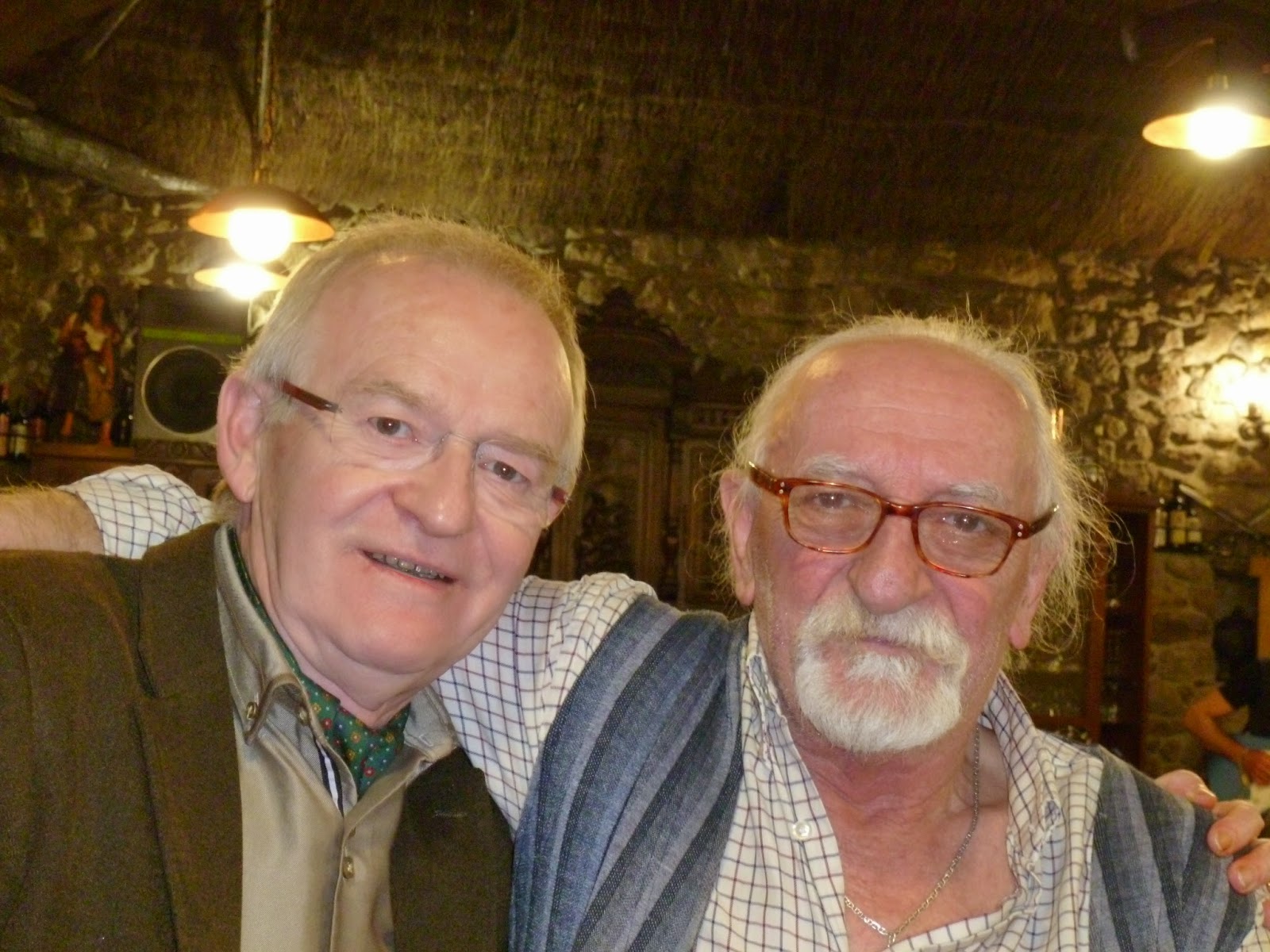 |
| David and Pepe |
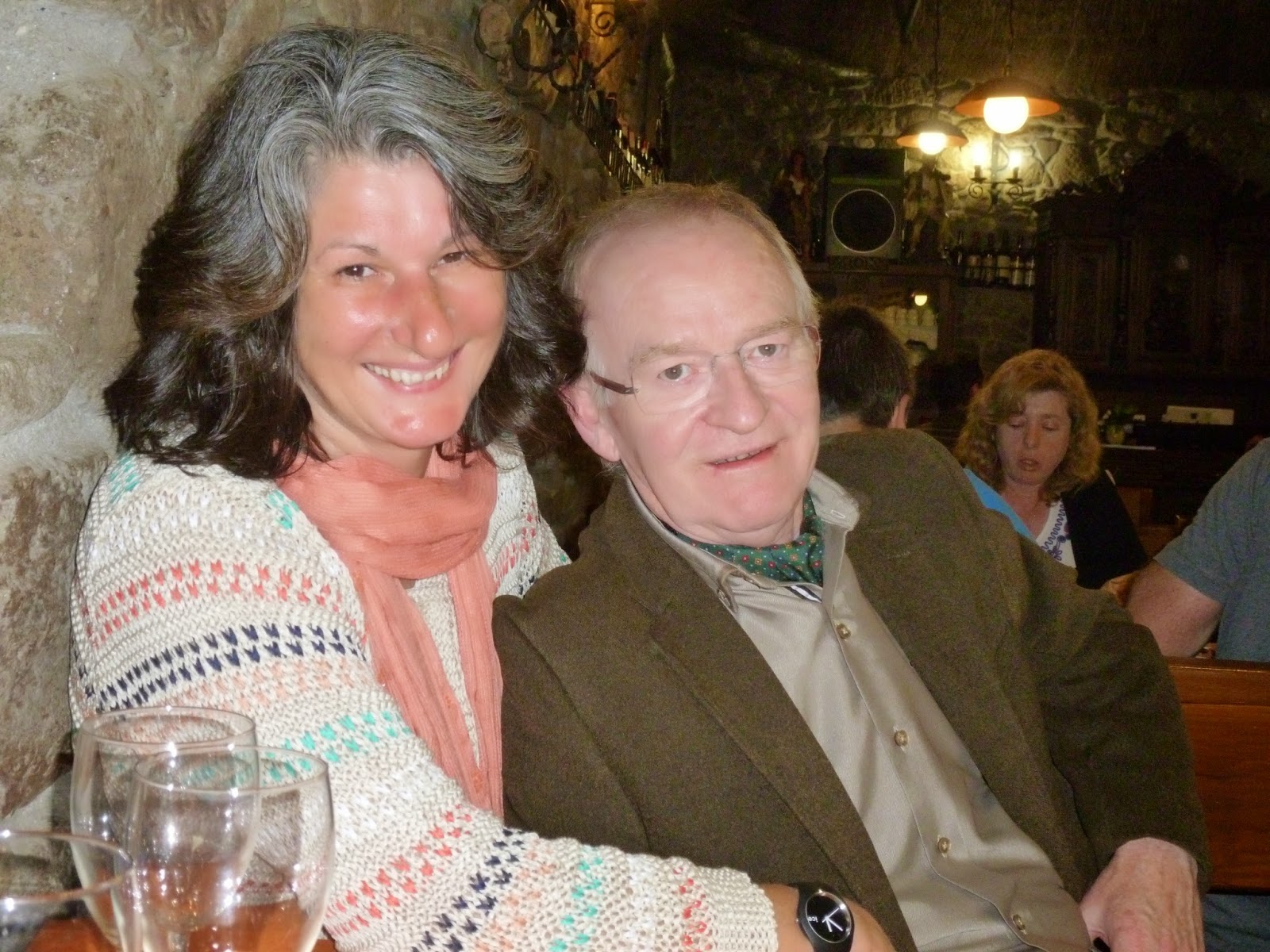 |
| David and Terri |
FIRST: The Friday after our arrival -- April 11th -- We went with friends Terri and David to what is known as a "casa rural," but also includes a restaurant/bar and week-end entertainment. The name is Torre Vilariño, and it is co-owned by a cool hombre named Pepe. Alas, I don't know his full name, but here he is with David. And
here is the website, which has lovely pictures of the rooms where one can stay, as well as the restaurant and patio.
On this particular Friday, two main musicians were playing. We had dinner first (around 9:30), and the music started around 11:00 p.m. One of the musicians sang, both of them played, and they went through a whole gamut of popular songs from the 80s -- in English. They were really good. Here are a few pictures:
 |
| The main duo. |
 |
| The singer. |
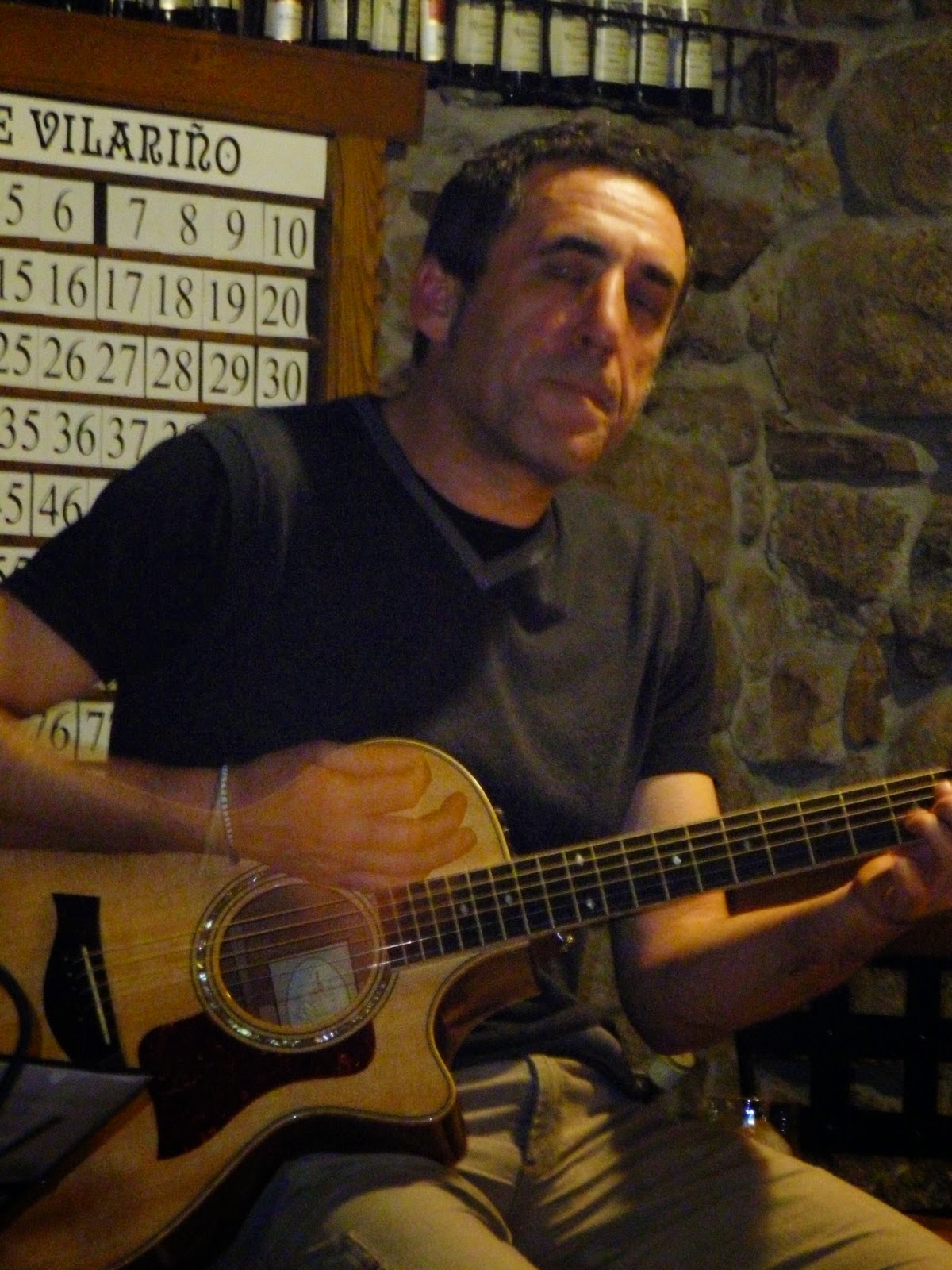 |
| Hearfelt guitar work. |
Occasionally a third musician joined them and sang along. They had a good sound! (I wish I had gotten the name of the group.)
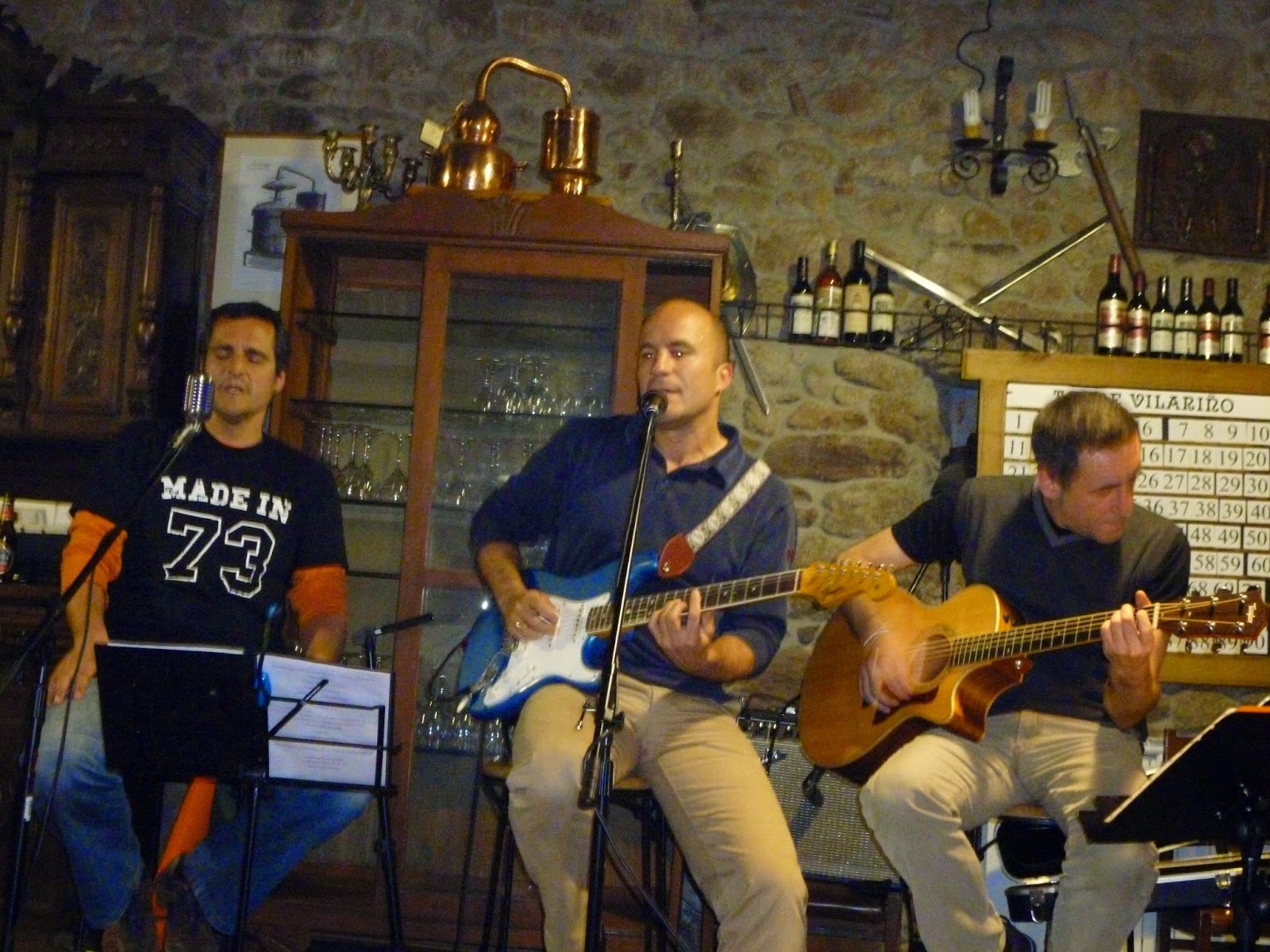 |
| Jamming! |
 |
The servers thought they were
pretty good, too. Singing along
with great gusto! |
 |
| Susana, server extraordinaire! |
The SECOND event was the
Fiesta Medieval that takes place each year at the end of
Semana Santa (Holy week). It used to only take place on Saturday, but now it has grown to include the entire week-end. We went both days. We love this fiesta, many locals dress up in costume, and small skits and re-enactments are put on in main streets and plazas. I'll let the pictures speak for themselves:
 |
Processions . . . this is a special
galician bagpipe called a gaeto. |
 |
| A medieval damsel . . . |
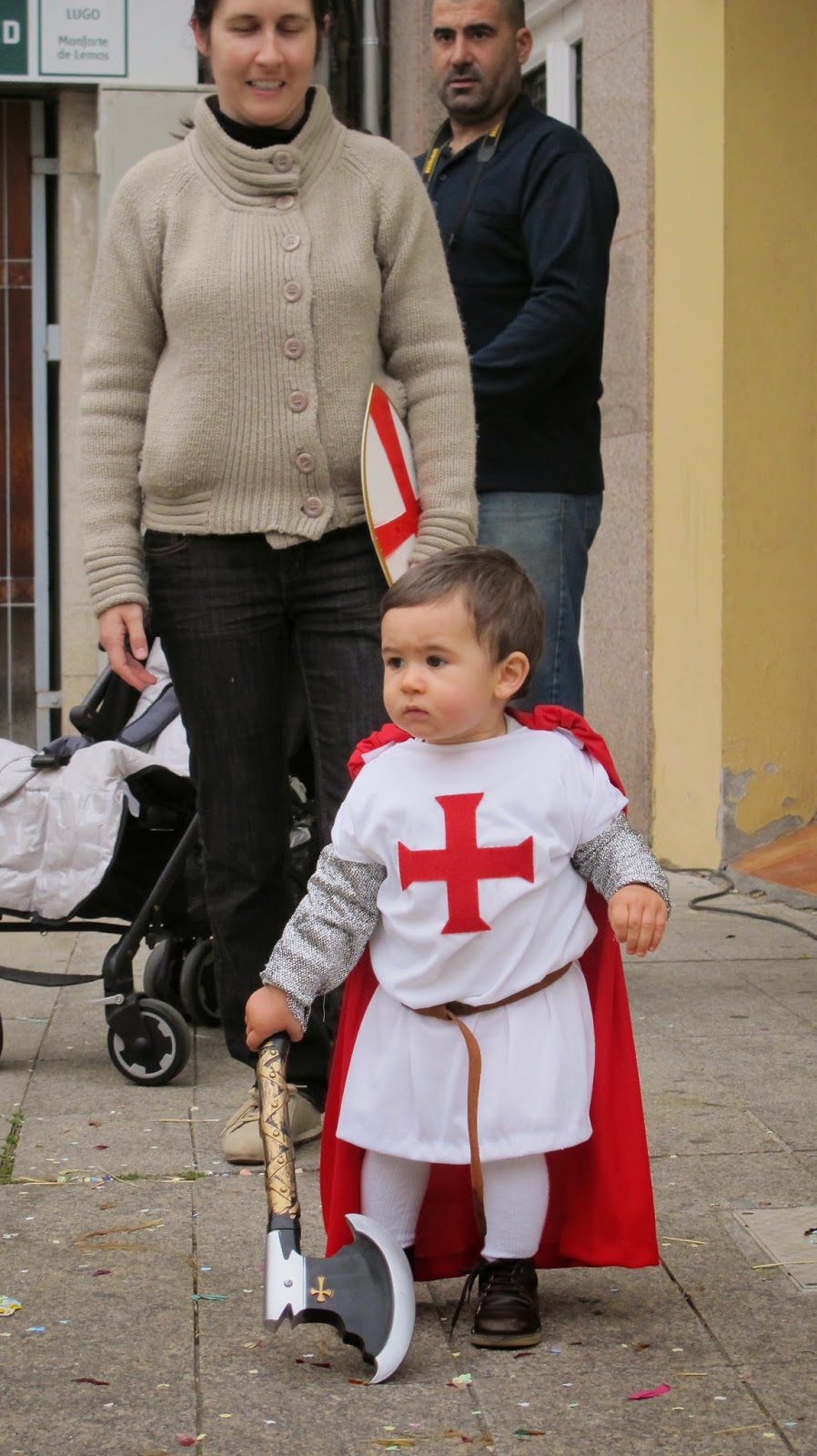 |
| A verrry young knight Templar! |
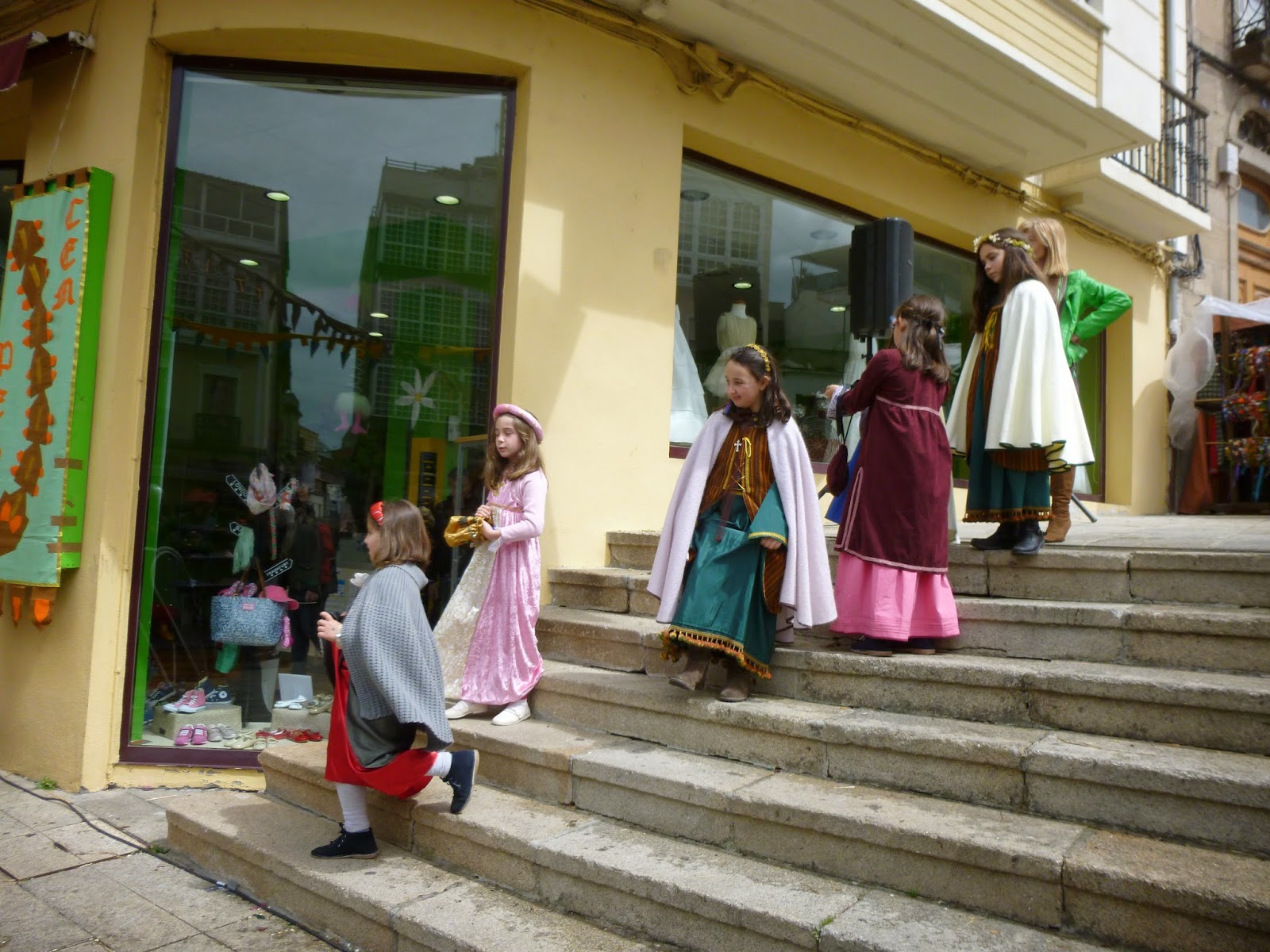 |
| From one of the plazas. |
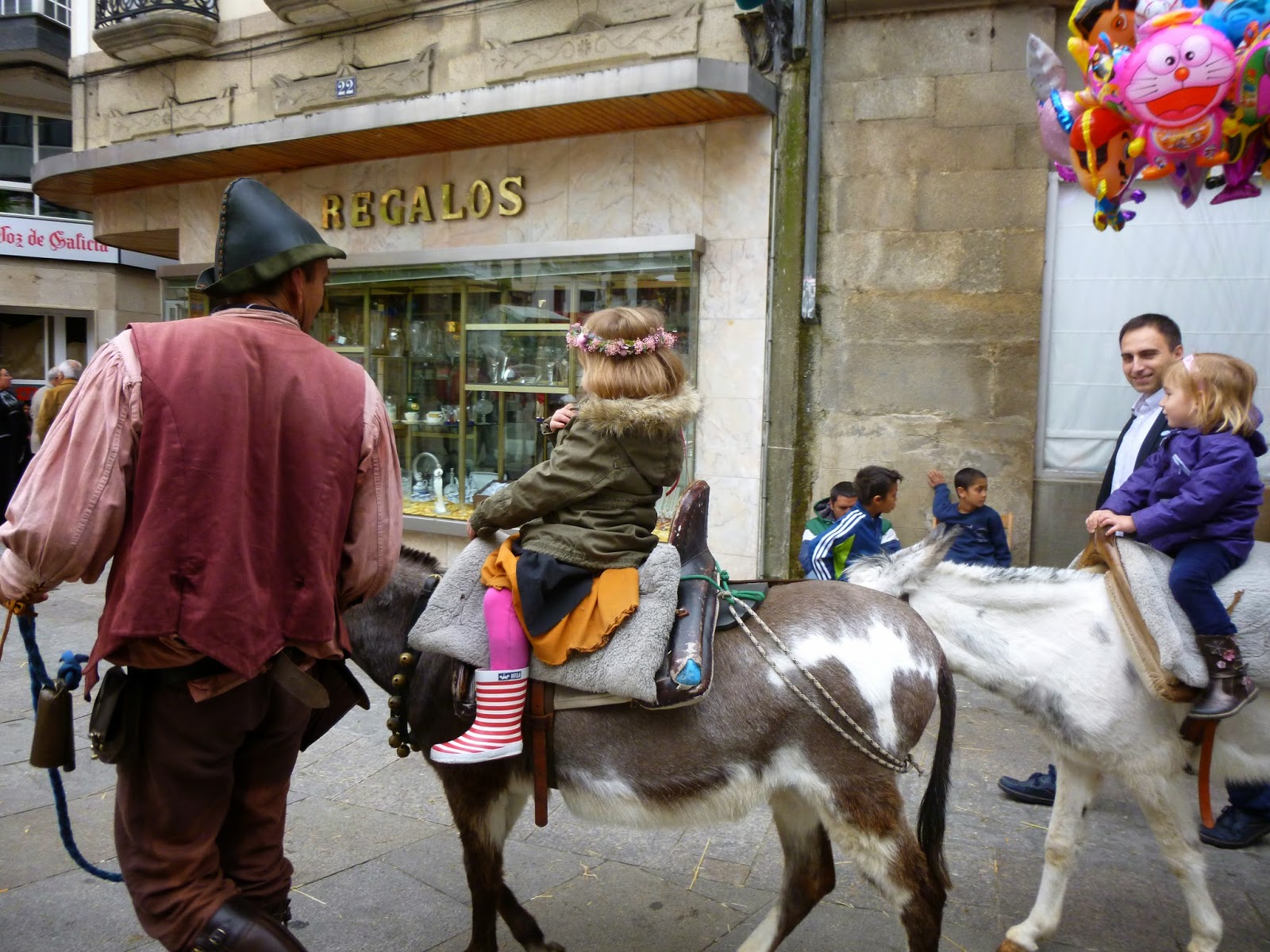 |
| And the little ones on burros! |
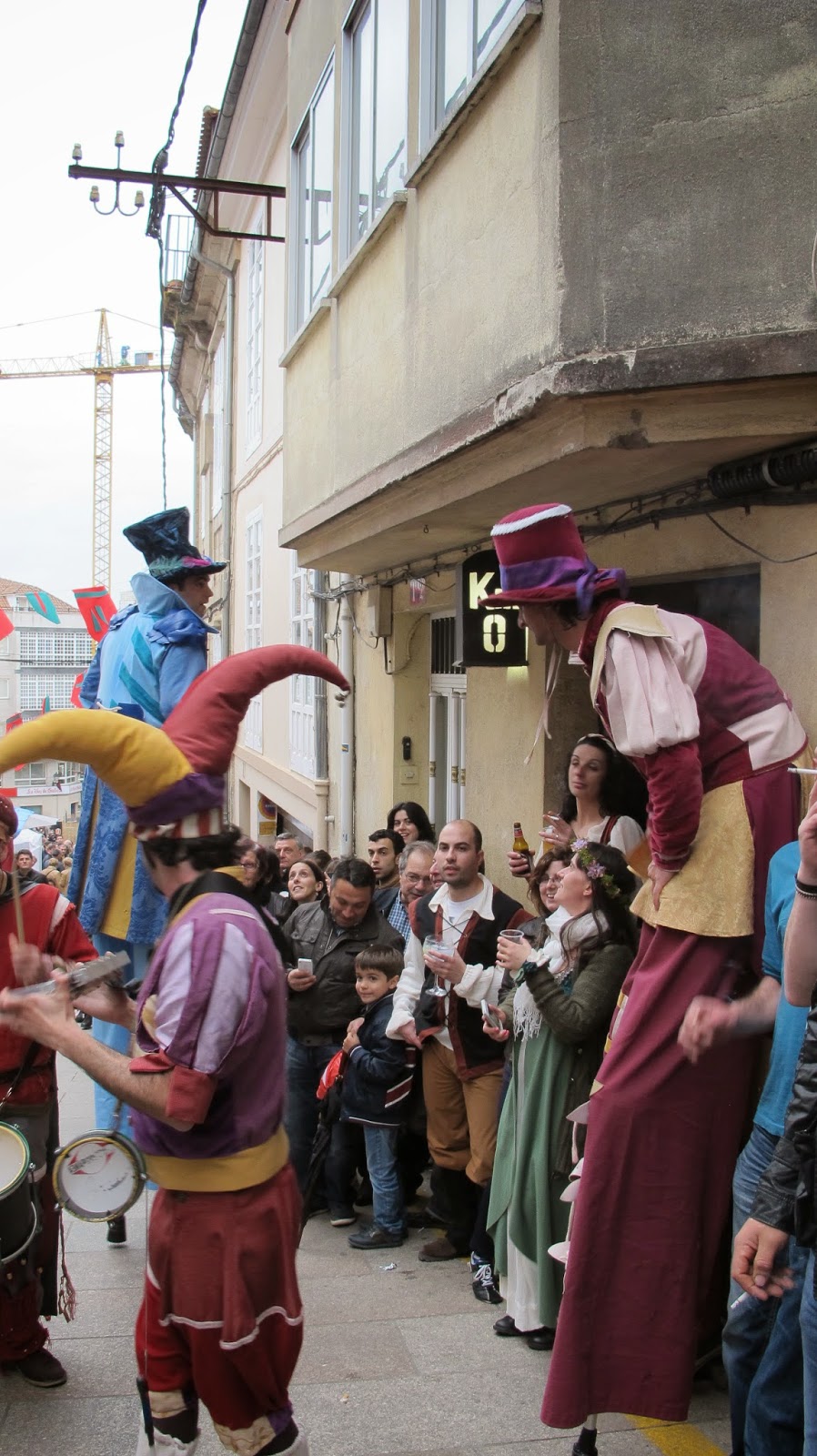 |
| Entertainers on stilts. |
 |
I don't know how
they do it! |
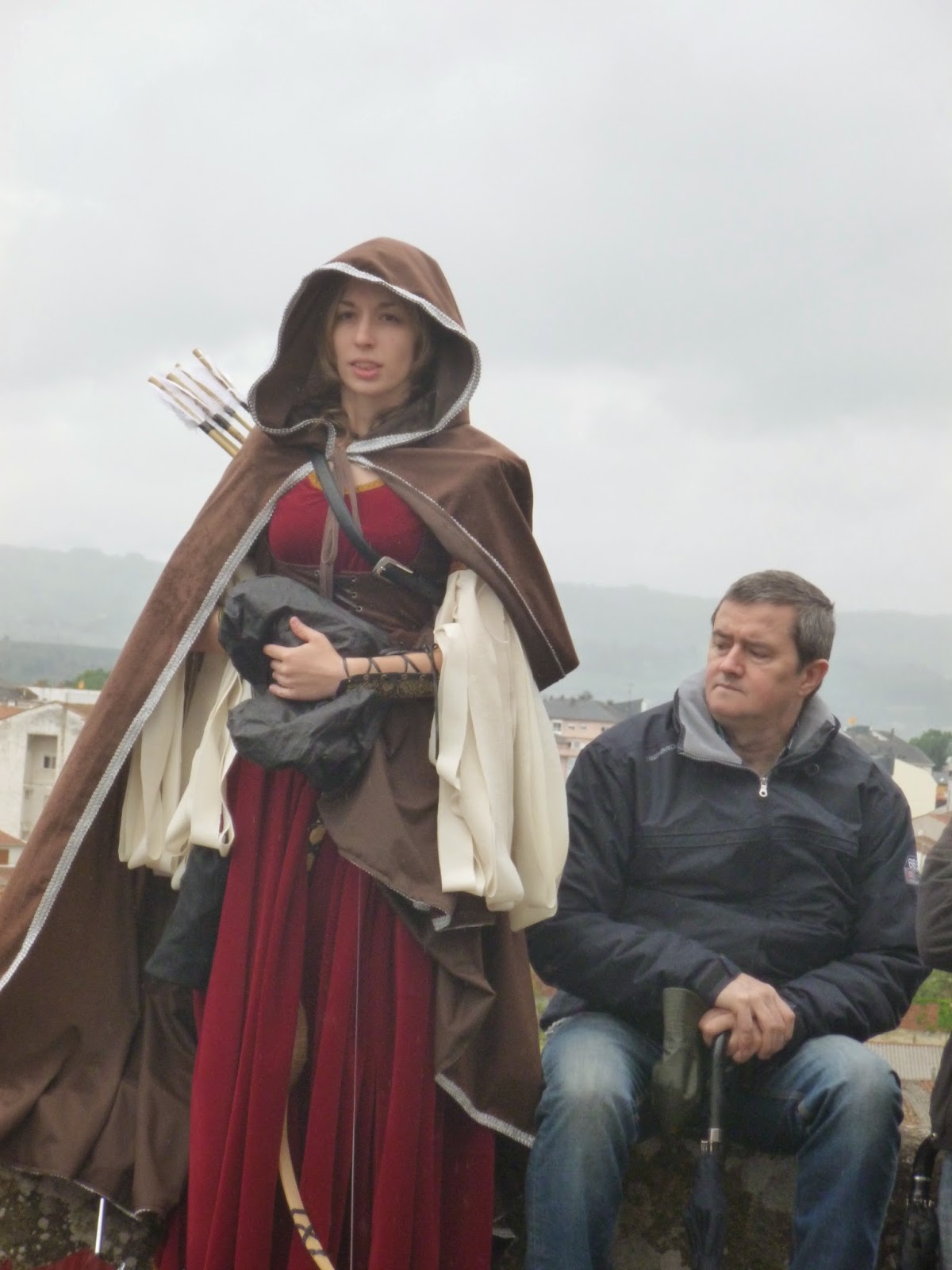 |
This woman was really into
her role. |
 |
The ever-present
witches. |
 |
I suppose this is where the knights
collected their helmets. |
 |
To defend their king and queen.
(Isabel and Ferdinand). |
 |
| King of Castile y Leon. |
Another feature of this festival each year that we particularly enjoy is the showing of the raptors -- hawks, falcons, owls, ravens . . . Two trainers have taught them to do tricks, and they are always fascinating to watch, not to mention what beautiful birds they are:
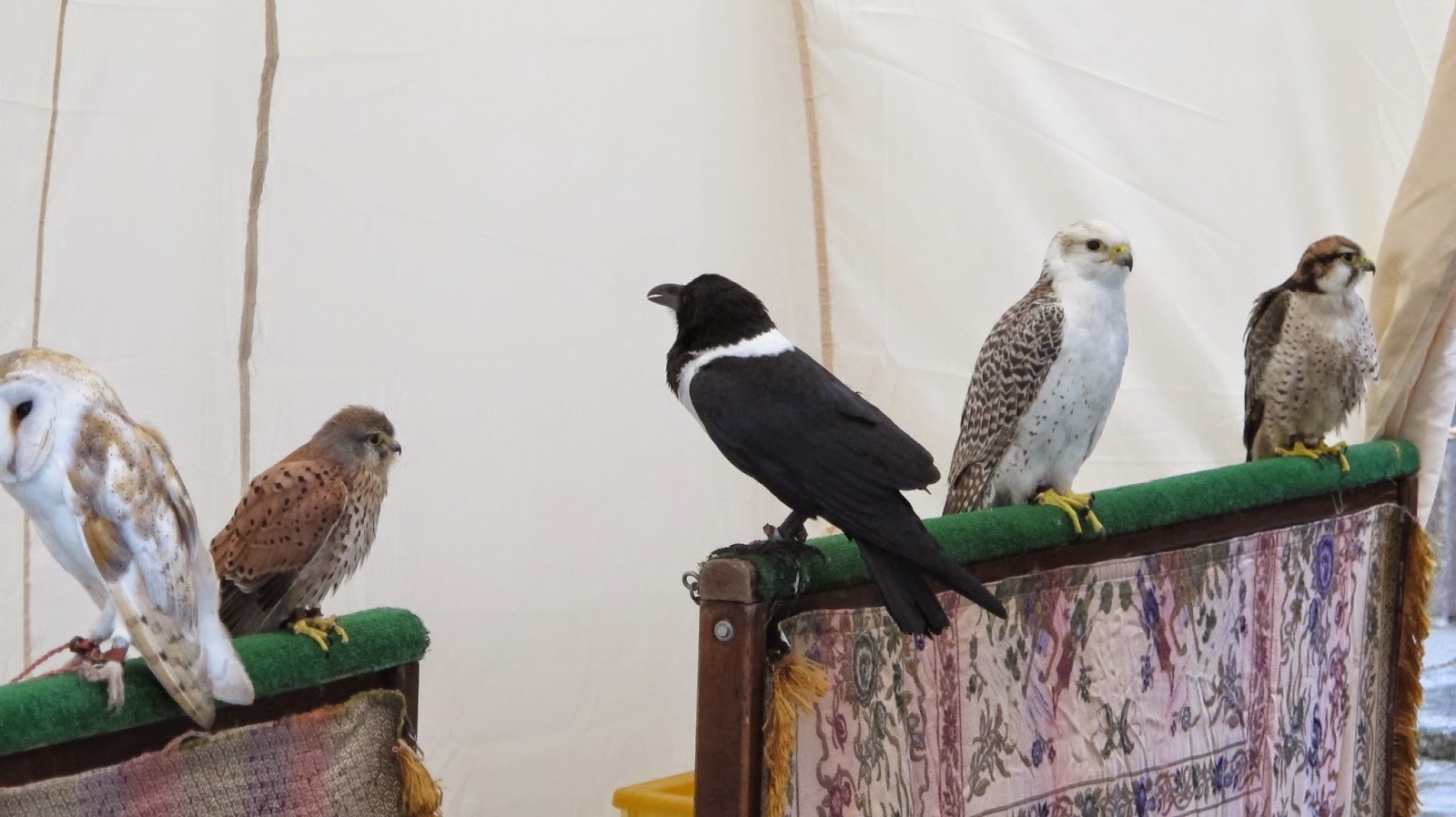 |
Such beautiful birds! I think they said
this unusual raven (with the white stripe) is distinctive to Galicia. |
 |
| The horned owl is so commanding! |
 |
But this hawk is pretty
impressive, too. |
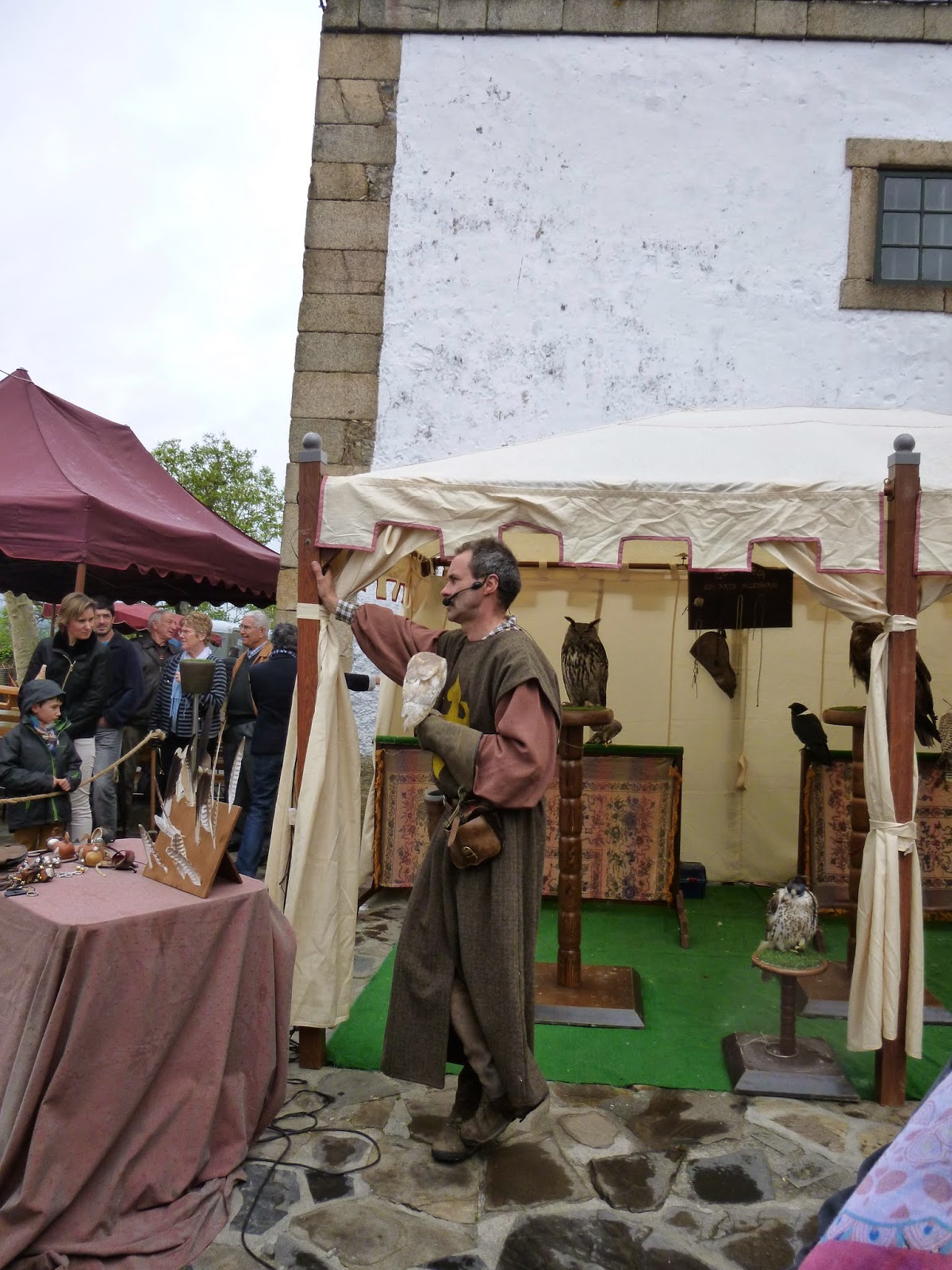 |
| One of the trainers and a snowy owl. |
 |
The other trainer watching
a falcon he released. |
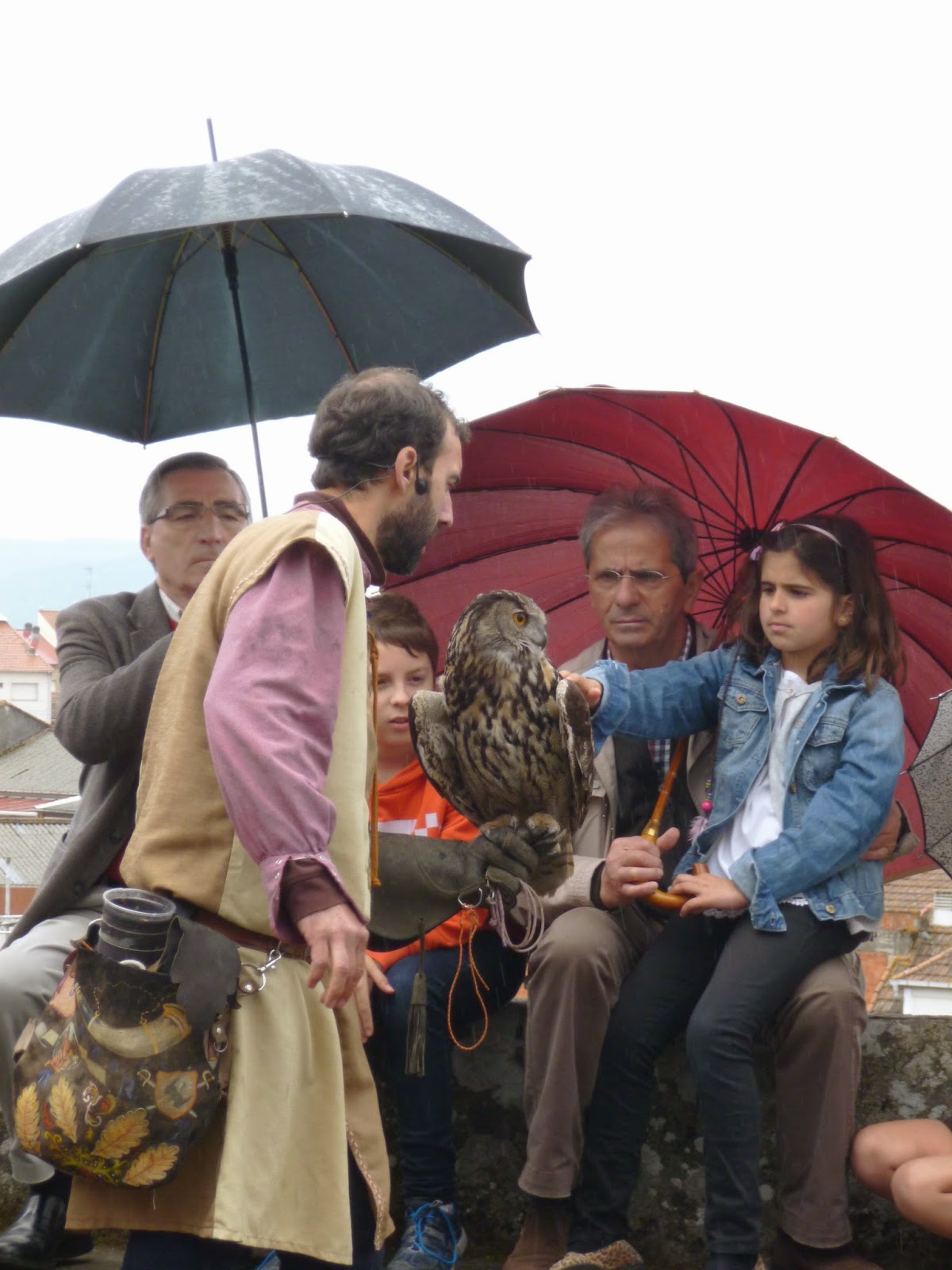 |
They finished off the show
with an interval when people
could pet one of the birds. |
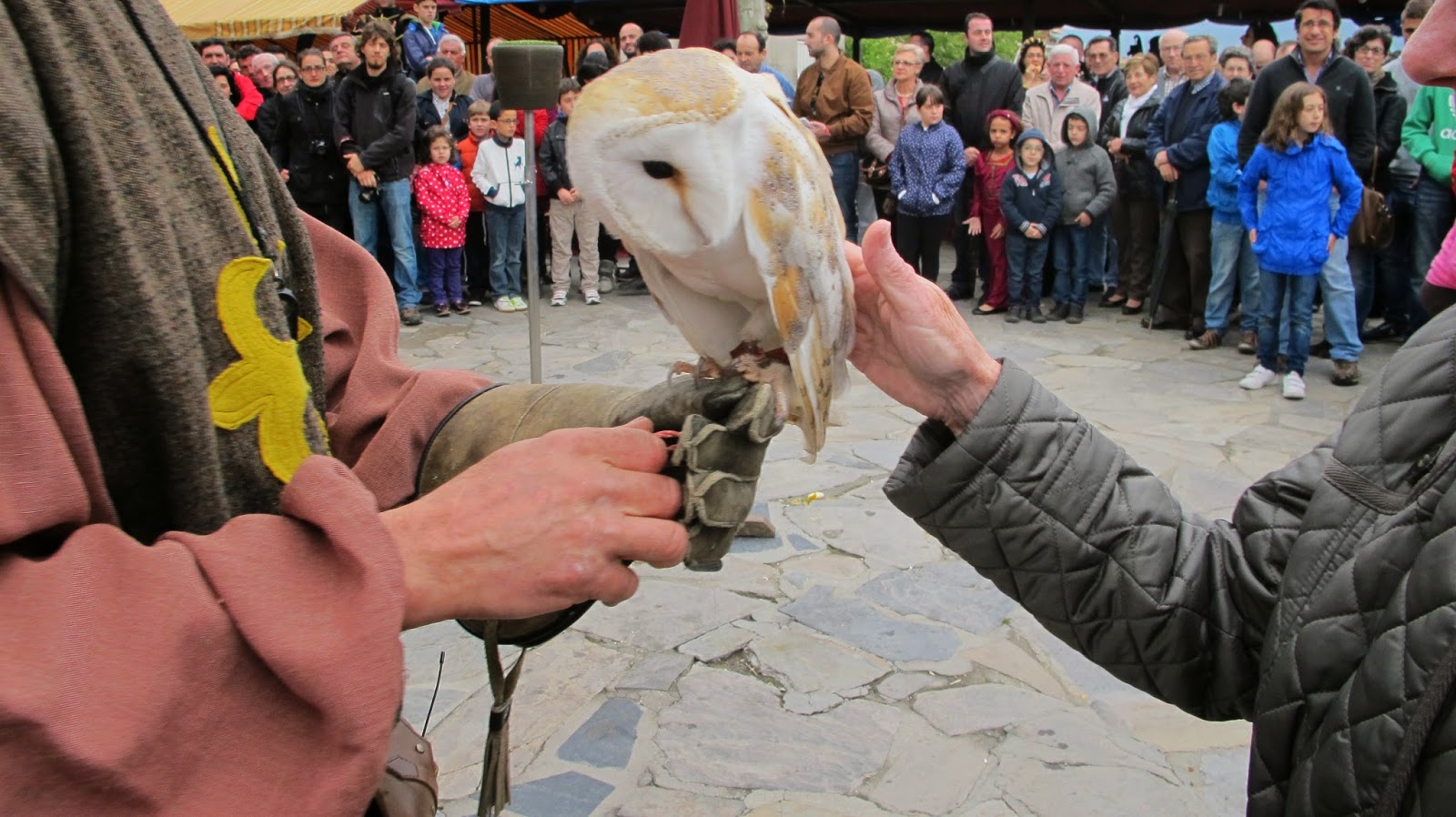 |
And who would you guess is petting that snowy owl?
Yup. Yours truly. It was really an awesome experience. |
So there you are: Two "local" events we thoroughly enjoyed. I hope you enjoyed them too.
How about you? Do you enjoy historical fairs and festivals? Have you ever petted a wild bird?

O
riginally we had planned to spend all three days, Saturday, Sunday, and Monday in Salamanca and return Monday afternoon. But the desk clerk advised us that on Monday everything would be closed. So we decided to go to Toro that day instead.
Toro is an unbelievably beautiful municipality in the province of Zamora, part of the autonomous community of Castille-Leon. It's high above a fertile plain known for its wines (from the Tempranillo grape), and recently Rajan has gotten interested in Toro wines, so that was also part of the inspiration for the trip. You can see how the buildings beckon one from afar.
This is the kind of country we traveled through to get there. Beautiful, and lush and green. Appartently a lot of farming goes on in this region. But the Toro region is becoming more and more known for its wines. When we arrived and parked, we started walking around and one of the first areas of interest we came to was an overlook point with a plaza around an old, intact wall enclosing a rectangular area with round towers at various points. A gardener told me was from Roman times. (My Spanish is still limited, so I couldn't really learn much more from him than that.) Here it is:
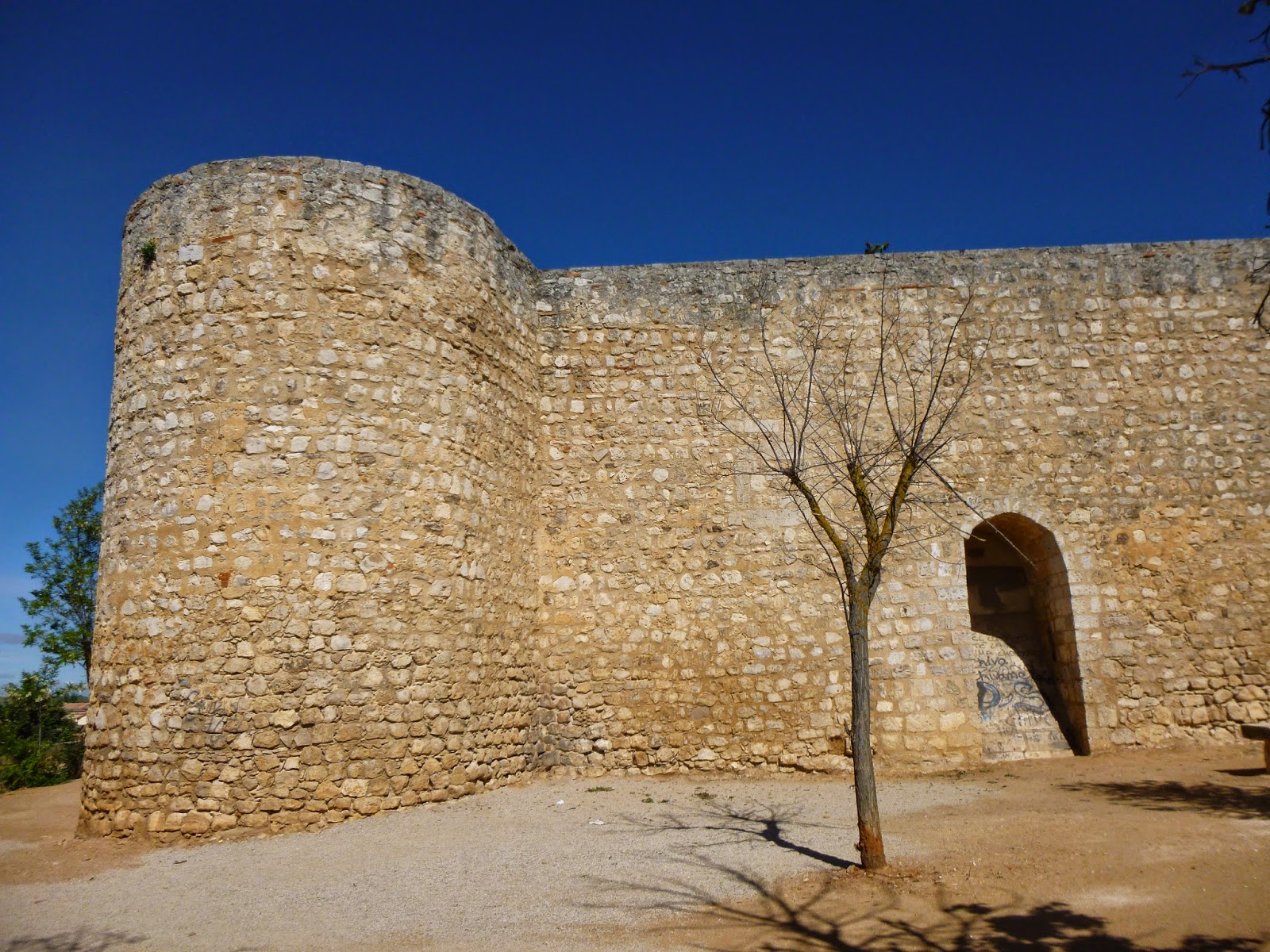 |
One view of the structure at one corner.
There were towers at each corner and
also in the middle of each side of the
rectangle. |
From the enclosure's condition, it may actually be from a later date. I looked Toro up in Wikipedia, and Toro was once a Roman town. The article mentions remains of a wall going back to 910, but, as you can see here, this is far more than "remains." |
Another view. Each corner
had a round tower. |
 |
Heavy doors were in walls on each
side of the structure. |
Since battles took place in Toro between heirs vying for the Spanish throne, this might actually have been a fortress. Plaques mentioned the crowning of King Ferdinand III in 1230, and that Isabella I of Castille defeated Juana La Beltraneja there, and that her father, Juan II of Castille, was born in Toro in 1404. But if anyone else can find out more for me about the structure itself, I'd appreciate the information. (Isabella I, by the way, was the Isabella who married Ferdinand II of Aragon, and they are the famous couple behind the Inquisition in Spain and the financing of Columbus's voyage to what became known in Europe as "the New World.")
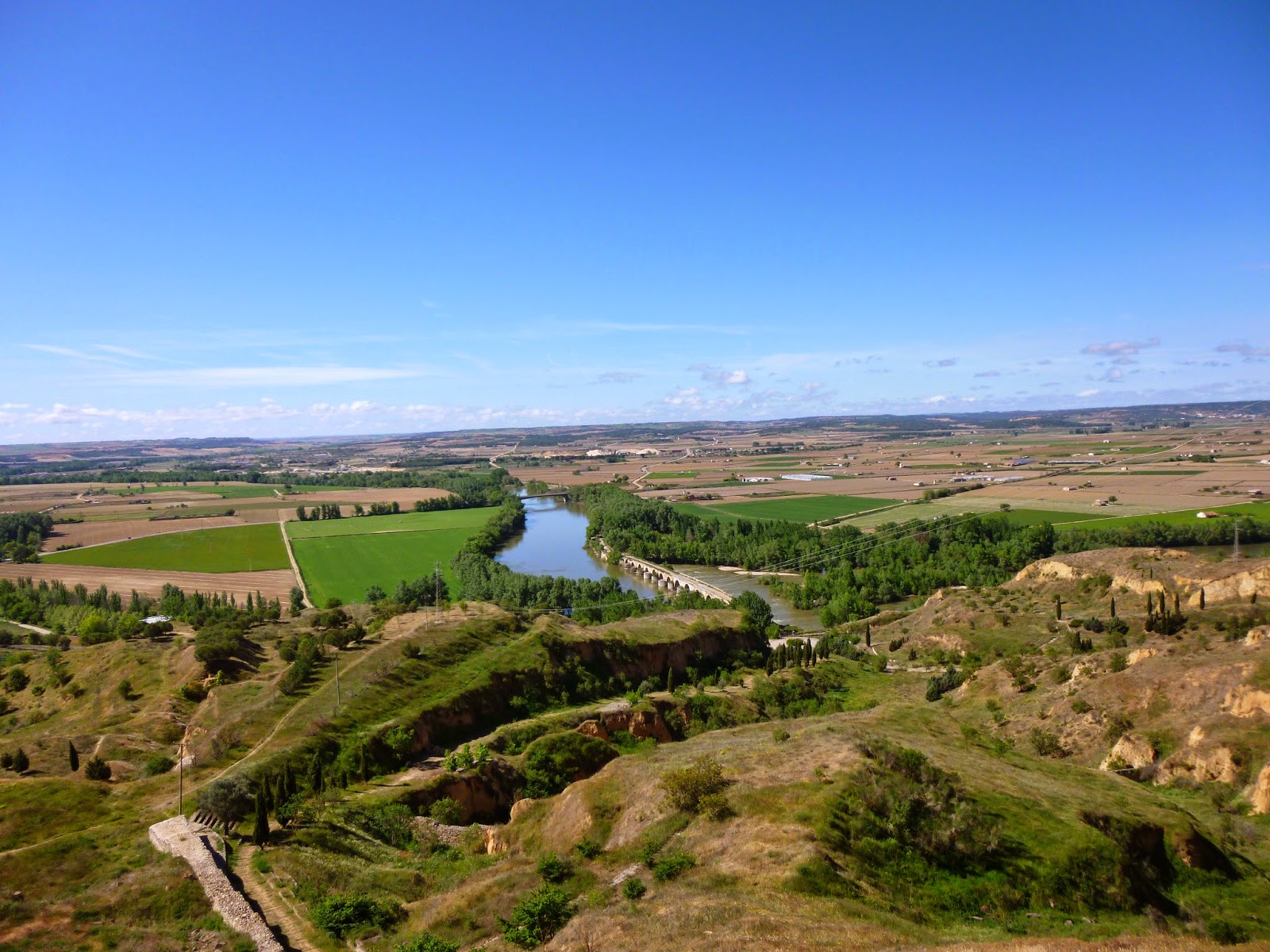 |
| The Rio Duero |
 |
Red tile roofs that seem so typical.
|
Since it really is a grand look-out point, Rajan and I took tons of pictures of the vast plains and the Rio Duero below. (The Rio Duero cuts through northern and Central Spain and flows on south to become the Rio Douro in Portugal, which ends at Porto.) Here are a couple.
Here is a video he took that I think you will enjoy:Then we all wandered around the beautiful city, admiring the architecture and the color of the buildings. Here are some pictures of a church that is considered a "must see" in Toro, Collegiate church of Santa María la Mayor.
 |
The buildings have such a
golden tone. |
 |
I felt like I was in Oz, at the
end of the yellow brick road. |
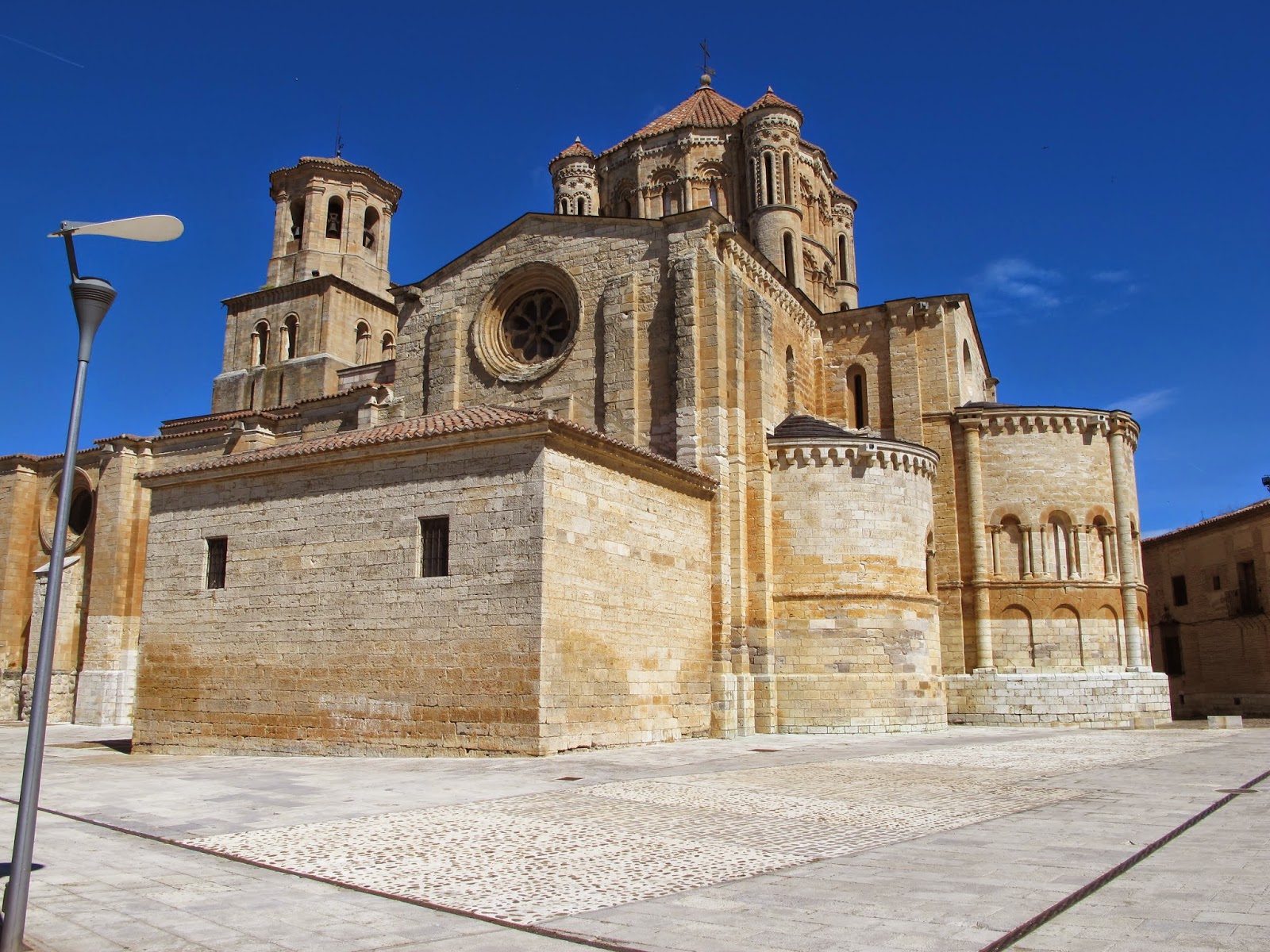 |
Here is the building in all its
splendor. |
One of the wine shops was open and the man inside was very knowledgeable about wines and wineries from the region. He spoke in Spanish, and we could understand most of what he said, but luckily our friends David and Terri are quite fluent, and so they were able to tell us whatever we missed. There are a number of wineries all around, but, again, most of them were closed. Still, it's good information for the future, and we bought some wine from the shop.
Meanwhile, the town was bustling with people out and about. I saw a beautiful arch at one end of a street, and a woman told me that it had been made with wine. Seriously. I think what she meant was that wine was mixed with the clay instead of water. But what a unique feature! She also tole me there was another arch at the other end of town, so of course I had to go there.
 |
| People out and about. |
 |
The arch made with wine,
which may account for
its color. |
 |
The other arch. Presumbably
not made with wine. |
After that, it seemed time to go, as there was a long drive home to Galicia and our part of Galicia. But it was a day well spent, and we were so glad that we had decided to take this little side trip on such a beautiful day.
I hope you enjoyed this little peek into this area of Spain. The next posts will still be about the earlier weeks in Galicia, before our trip to Braga, Portugal; and then I will follow up with pictures and posts about Braga, a most remarkable and wonderful city.
Till then, please leave a comment, and if you have any questions, I'll try to answer them. Also, if you have any additional information for us about Toro, please leave it. The turism office was closed that day, and there isn't an awful lot on line about this beautiful town.
Already it has been two weeks since our return from Salamanca, and even then, we returned via a different town in the Toro wine region, called, aptly, Toro. But first, the beautiful city of Salamanca in the province of Salamanca, which is in Castilla y León, one of the seventeen autonomous coummunities in Spain.
Here you see the old part of town, across the Puente Romano (Roman Bridge), the buildings eternally glowing a soft apricot/rose/peach from the soil and clay from the area.
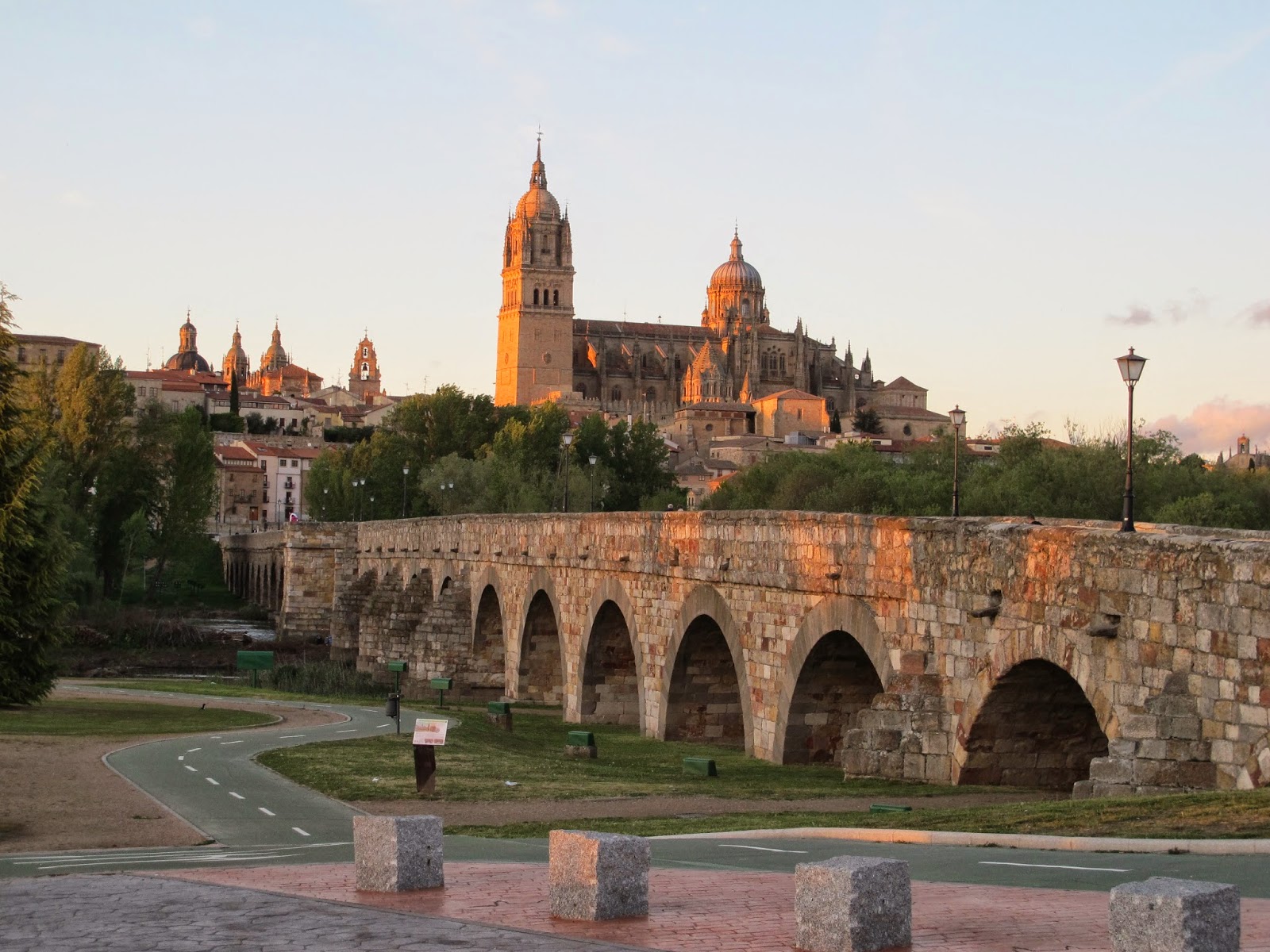 |
| The old part of Salamanca, across the bridge, late afternoon. |
The trip was to celebrate with our friends, Terri and David, our mutual 40th anniversary. Ours was on December 22nd, and theirs was on February 15th. We had agreed a few years ago that when the 40th came, we'd go to some special place during the spring trip to Galicia. Salamanca was a good choice.
We left on Saturday and spent two days in this beautiful city. What you see in the foreground, across the Puente Romana, are the domes of the New Cathedral (new meaning it was built between the 16th and 18th centuries—in two different styles, Gothic and Baroque.) In the background are the La Clerecía Towers, domes of a church and ecclesiastic college begun in the 17th century. (More about the latter later, including a neat video of storks that make their home atop the Cathedral.)
 |
| A closer view of the Cathedral |
But first, of course, we had to get there. It's about a four and a half drive to Salamanca from our area, and you go through some gorgeous scenery, leaving the stone walls and red tile roofs and the terraced vineyards of this area and encountering rose and ochre brick and stone walls of the villages nearer Salamanca and vineyards in rocky flat soil—soil that the vines seem to like: We've been told the harsher the soil, the better the wine.
 |
Unlike neighbors and vintners in our
area, the growers here seem to cut
fhe vines very close to the ground. |
We passed hills striped with purple heather and golden gorse and some bright yellow fields of rape blossoms grown for rape seed oil. At times it was like a painting by Cezanne. Red tile roofs changed to black slate in one area, and we saw milky white cows that, at first, we thought were sheep (we are so used to the golden brown cows herded by our Galician neighbors.
The first day in Salamanca we wandered around, enjoying shops, the cathedral and university and seminary buildings. And walking along the beautiful Puente Romano.
 |
Our hotel, also names Puente Romano,
was on the side of the bridge facing this
picture. Everything was at a walkable
distance. |
We spent a lot of time at a wonderful museum called, Art Nouveau and Art Deco Museum, housed in the Cas Lis. Originally a small "palace" (from the brochure), built in the early 20th century for Don Miguel de Lis, an aficionado of Art Nouveau, it later became the current museum mansion that now houses statues, statuettes, furniture, stained glass artwork, dolls, paintings, all by leading artists and artisans of the genre. It's a remarkable building with one whole wall of stained glass windows on two floors, a hallway with a stained glass ceiling, and beautiful architecture and gardens and gatework outside.
 |
| Add caption |
 |
Another view of the
ceiling, as well as one
of the windows from the
inside.
|
 |
A beautiful painting gallery below and
interesting rooms of statues, dolls,
etcetera, in other rooms. |
If you go to
this site it will show you some of the remarkable features of the building outside that I mentioned. And
this site will show you more of the interior.
There were weddings going on in the city, so one of the restaurants Terri and David wanted to take us to was all booked up. We did have a wonderful lunch of
raciónes at a convivial cafe called
Erasmus , enjoying
bacaloa (cod) croquettes,
gambas gabardines (deep-fried battered shrimp, and
pimientos de padrón, small green pimientos sautéed in olive oil and sea salt, and one of my favorite ever dishes when we come to Galicia.
We went past the cathedral several times trying to get good photos of it. (There was a lot of shade.) The doors and sculptures on all sides are spectacular, though. Here are a few examples.
 |
It's hard to convey how
magnificent it felt to
stand under these arches. |
 |
You can see the size of
the doors by the size of
the passerby. |
 |
These people give you
even a better idea. |
After all the walking around in the fresh air, we were tired and hungry. We went back to the hotel to rest for awhile, and then we went out for a late dinner. (Dinner is always late in Spain.)
The place that we discovered was a charming bistro named Zazu that specialized in a Mediterranean menu. We don't have a picture of the restaurant
per se, but this site will give you an idea of
their atmosphere and menu. Our server found us a table in a small upstairs room that was softly lit and full of artwork on the walls. He was from Germany, but he spoke excellent English and was so attentive, you could tell he really liked his job. If you go to Salamanca, we all recommend this place. For starters, I had grilled vegetables and Rajan had crabcakes, and then for the entrée we split an order of squash-stuffed raviolis. The wine was Gewurtztraminer for Terri and myself, and the gents had a red from the Toro region, followed by excellent
café. Then our friendly waiter kindly took a picture of us before we left.
 |
Here we are, enjoying coffee, trying to look natural for a picture at about 1:00
a.m. I have never figured out why, but coffee in Spain doesn't interfere with
our sleep. By the time we were back at the hotel and retired it was 2:15. |
Day Two was another day of sightseeing and some surprises. We wandered around the old streets, taking pictures of the buildings and shopping. Street musicians were situated in main walk areas, and the one below was especially interesting, tuning, and later playing what I think was a zither.
 |
The instrument made a delicate sounding music. Here he's
just tuning it and getting ready to play. |
It was a sunny day, and especially good for taking pictures of the Cathedral.
 |
| Looking up, up, up. |
 |
| Stone carving like lace. |
 |
| Statues everywhere. |
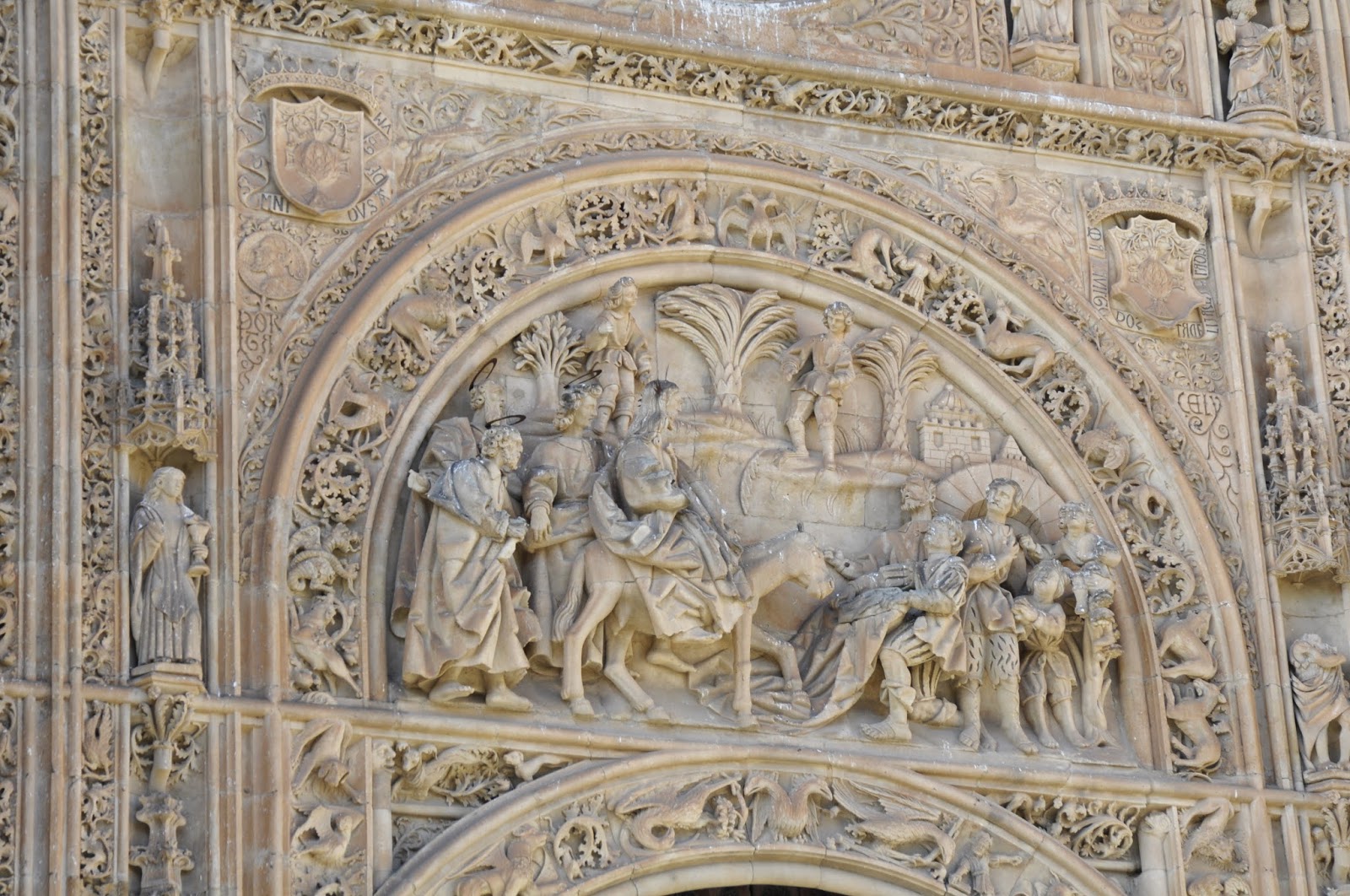 |
| This is just one example of the kinds of carvings over doorways. |
Then a real suprise lay ahead when we went up one of the towers of La Clerecía, the church and ecclesiastic college shown at the beginning of this post in the background. The stairs were old fashioned, wooden, narrow, about twelve or fifteen to a landing, and the went up, up, up. I don't know how many we climbed, but it was well worth the view of the city once we got to the floor where most of these pictures are taken. There are little balconies at all the windows of the tower we were in, as well as a balcony that took us to the opposite tower, so we could see th city below from many angles.
 |
| A view from one part of the tower. |
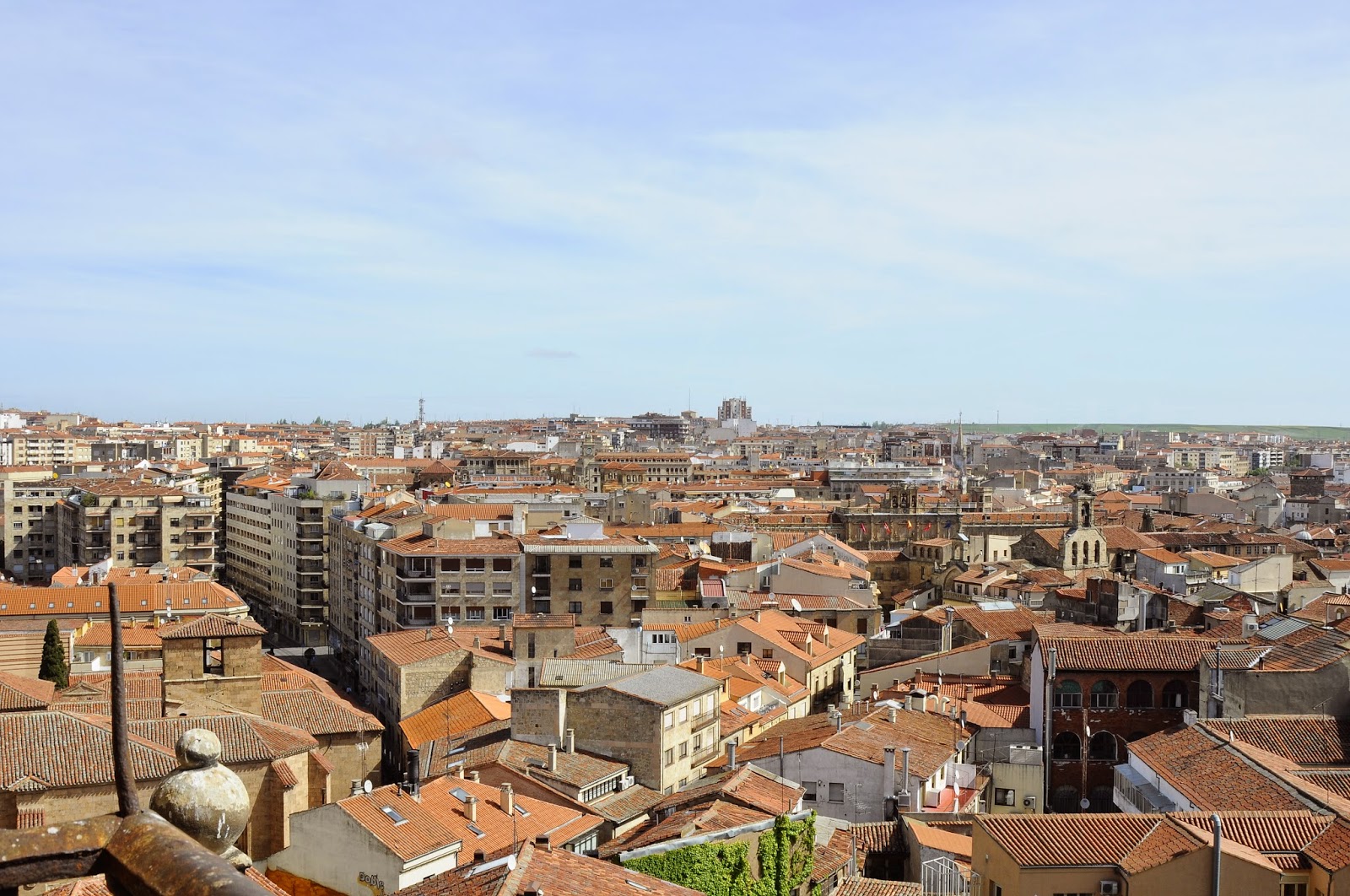 |
| More of this beautiful city. |
 |
| From another side of the tower. |
 |
This looks down on a small courtyard
enclosed by the walls of La Clerecía. |
 |
This is one of the domes of the Cathedral,
and at least three storks had nests around
the domes.
But the biggest surprise was yet to come when Rajan went up to the top level. He was able to take a video of one of the storks with its young. Enjoy this short movie of a stork family:
The other enjoyable event of the day was lunch at the Plaza Mayor, a huge square enclosed by restaurants mostly on the ground floor, apartments on the other floors of three of the walls, and a concello with administrative offices forming the fourth wall (the one with all the flags.) We sat at one of the outdoor tables and split raciones again, this time pimientos, potatas braves (cubed and fried) and battered shrimp, with our wine. And then we just people watched for the longest time. The plaza Mayor is a main socializing place for the city for people of all ages.
You would be surprised how long one can "people watch" in a place like that. And so many people were so stylish!
But then it was time to go back to the hotel, rest up, and get ready for going out for the "big dinner." In addition to being the anniversary celebration over the week-end, Sunday was David's birthday. We all dressed up, and, wouldn't you know it, didn't take a single picture. But we did eat at a remarkable restaurant called El Alquamista. Lot's of atmosphere, wonderful service, delicious food.
This ends Part One of the trip, but come back for Part Two, because the trip to Toro the following day was quite an interesting day.
Thanks for stopping by. I can't think of a question to leave with you, but please feel free to leave a question of your own, and I'll try to answer it or find the answer.
|

With blog problems these past few days, I'm behind in my posting. Last Friday was a fabulous evening at Torre Vilariño (a later post and photos will come), and we spent both Saturday and Sunday in Monforte enjoying the Medieval Faire (again, a later post and pictures will come).
First, though, I have to share a concert we attended in Quiroga by a fabulous fadista (Fado singer)— María do Ceo. She's very popular here and famous worldwide.
I first heard María do Ceo sing last June when she gave a concert at Rectoral de Castillon. At that time, I bought the CD shown to your left, and I blogged about it
HERE. It was an unforgettable evening, and my first exposure to Fado. (That was when Rajan and I we were taking turns with trips while the other nursed our ailing dog during his last days.) When I returned home and played the CD for Rajan, he loved Fado. Attending one of her concerts became a priority for this trip.
We went with friends Craig and Melanie, who hadn't heard Fado before, and they became converts, too. At the end of the concert, we gathered with others to get María do Ceo's autograph. She is a remarkable performer, and very down-to-earth and unpretentious after performances. Everyone was having their picture taken with her, and she welcomed us to have our picture with her too. What a treat!
 |
After a long concert, she
still had buoyant energy
as she signed autographs. |
 |
She took time to converse
with people who lingered.
A truly gracious person. |
 |
She remembered my name (from FB
and the early blogpost.) A very
modest celebrity who makes you
feel welcome and at home. |
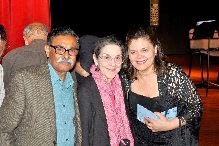 |
| I enjoyed introducing her and Rajan. |
 |
She was kept pretty
busy with autographs. |
You can go to her website and see her CD's
HERE.
We bought a new CD that we enjoy as much as the first one, and now I wish I had bought more. Each one is unique. The one we bought isn't shown in the Discography section on her website above. But there are many performances by her on YouTube at
this site, so you can get a feel for her singing.
Fado, as I mentioned in my earlier post, is a distinctive art form of Portugal, similar in one sense to American Blues, in that it is emotional and comes from deep in the heart and soul. But Fado has a variety of influences, one of them Moorish, and you can hear that in the warbling minor trills in some of the songs. The word itself means "Fate." Usually the songs are about deep yearning and thwarted dreams. Some of them can have a cheerful beat, but it's a fatalistic cheer, dealing with life's outcomes. It's not depressing, though. It's a response to what life deals you. I'm hooked on Fado, and if I can find another Fado concert, I will. Unfortunately, we will be gone before María do Ceo's next concerts in Galicia, but we will watch her schedule and hope to hear her during our next visit in the fall.
María do Ceo is from Portugal, but she lives in Ourense, Galicia. Her songs are in Portuguese, but her singing is quite popular all over Galicia.
Gallego, or
Galego, or
Galician—all are accepted names for the Galician language—is a sister language to Portuguese, so all her songs are understandable to Galicians. I read recently that Gallego and Portuguese share 85% of vocabulary. Our neighbors, in fact, have told us if we knew Portuguese, we would be able to understand Gallego.
Meanwhile, I hope you will visit her website and enjoy the video site
HERE. I strongly recommend "Lela" and "Negra Sombe". But, really, they are all good.
How about you? Do you have favorite music genre? A favorite singer? Please share.


By:
Elizabeth Varadan,
on 4/15/2014
Blog:
Elizabeth Varadan's Fourth Wish
(
Login to Add to MyJacketFlap)
JacketFlap tags:
Spain,
trip,
Santiago,
airports,
Galicia,
Toiriz,
storks,
bucket lists,
Camino,
nature walks,
Trasulfe,
Add a tag
It's hard to believe that we arrived in Spain 8 days ago. Time flows by in a different way, even though we bring work with us. The trip is long, we arrive exhausted, but we have rituals along the way. The trip is more than 24 hours (door to door) and spans two days. We leave Saturday morning, have a long stretch in Dallas/FW Airport, where we have battered and fried green beans and a glass of beer at TGIF, waiting for our next flight. We arrive in Madrid around 10:30 a.m. Sunday, and have a lunch of smoked salmon, bread, and wine, then fight sleep while waiting for our connection to Santiago de Composetela. We arrive in Santiago a little after 5:00 p.m. and collect baggage. Our friends, Terri and David, meet us, drive us back to our house in Trasulfe, where we "turn on the house" (electricity, water, gas-tank connections, etc.), then we all go out to eat at a restaurant in Monforte, called O Pincho, where we split delicious raciones. (Rations are smaller than dinners, bigger than tapas.)
Here's a picture of Terri and David from last summer (we haven't yet gotten around to pictures of friends on this trip.) As soon as we got to O Pincho, we woke up and had a great time catching up on news, eating rations and drinking the house wine. The next morning, waking with the sun (about seven-ish), eating lunch at 2:00 p.m. and dinner around 8:00 or 9:00 p.m., Rajan and I realized we'd fallen into Spanish time right away, with very little jet lag!
Friends and neighbors tell us it was a continually rainy winter, but our first few days were sunny. There was the usual morning mist and intermittent sprinkles through the day that vanished in afternoon heat. Still, we felt free to bring out our patio table and chairs. Then things changed.
 |
The small pasture across the sheep
path in front of our gate. The thin
tree in the foreground is a volunteer
peach tree that so far doesn't bear. |
 |
A neighbor's pasture below ours.
See those little fruit trees? The storm
blew all the petals away. No fruit
this year. |
After four beautiful sunshiny days, on Thursday afternoon a fierce hailstorm struck. First thunder rolled and roared for about an hour, and then hail beat down for about thirty minutes. This was the result :
 |
| These aren't snow drifts. Just lots and lots of hail. |
I wanted to put a video here, with all its great sound effects, but I couldn't get my video to play. (I've sent to Google for help.) But this should give you some idea.
On another note, we've been making a point to walk at least two miles a day. In about a year, I want to walk a portion of the Camino that ends in Santiago. (One item on my bucket list.) I won't be able to make it to Santiago, but a friend informed me that if you walk 100 km, you can get a certificate. That's about sixty miles. Next spring I'd like to do about 30 miles, and then in the fall of 2015 do the second set. So far, a few times we've parked at Gadis, one of the big supermarkets at the edge of Monforte, and walked up to the Parador.
 |
Here's the Parador, seen from the Gadis parking lot.
Below is Gadis, seen from Parador, to give you and
idea of how far we walk. |
 |
Gadis, where we parked, seen from the Parador: See the thin pale blue
stripe about two thirds up in the middle? Above the center green? To the
left of that is a teeny yellow sign. That's Gadis.
Other walks have been along country roads. Beautiful nature walks, really. This will give you some
idea: The picture on the left is an example of most of the scenery here.
The picture to the right is of a pretty church in Toiriz. We don't have pictures yet of the stork nests, but on tall posts nearby, there are two separate stork nests, and we sometimes see one of the parent birds feeding the baby birds. All you can see is the upended body, so we aren't quite sure how big those babies get. Hopefully we'll get a good photo sometime soon.
And now, it's time for a walk! But stay tuned, because the next post will be about a wonderful Fado singer we heard Sunday night.
Meanwhile, if you have special items on your bucket list, I'd love to hear what they are.
|

The book has been sent to the contest. My last art club session was yesterday. Tomorrow we leave for Spain. But first, one last post about the cruise on St. Lawrence River, which continues to bequite a highlight in our travels.
 |
Greeters to Halifax, Nova Scotia.
(I personally love the sound of
bagpipes. They always sound so . . .
eerie and haunting, full of "story". |
 |
Our bus driver and tour
guide. Unfortunately, I
didn't get his name. |
Our fourth day out, we docked at Halifax, Nova Scotia and were immediately reminded of Nova Scotia's Scottish connection. Bagpipes and kilts everywhere. Even the tour guides met us in kilts, as two busloads set off for Peggy's Cove.
Peggy's Cove seemed a wild and desolate place. I've always been captivated by fog and mist, no doubt to stories I read when I was younger. Mysterious and magical things happened in foggy locations. I love Lighthouses, too, so this one captured my imagination completely:
 |
| A wild an desolate place. |
 |
| Desolate, yes, but beautiful. |
 |
A magical place where anything
might happen. |
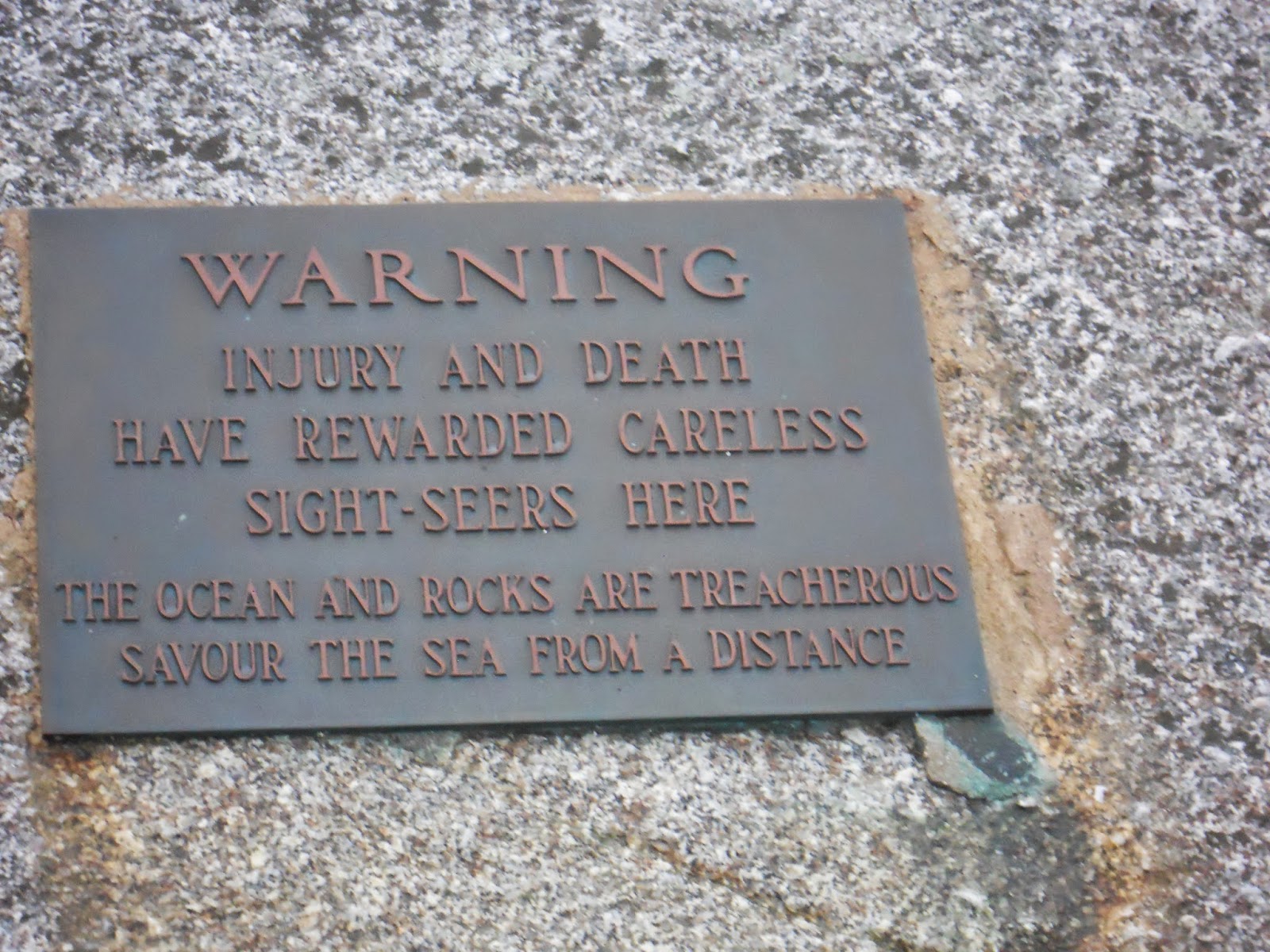 |
And a warning of what could happen!
|
And there was an official greeter to the cove as well, complete with kilts and bagpipe:
 |
| Official bagpipe greeter. |
 |
I did think it was a cold job
on a foggy day like that. |
 |
But he kindly consented to
a photograph with me. |
And then it was time to board the bus again and travel to Fairview Lawn Cemetery. Why a cemetery? A whole section of it contains graves of 120 to 150 of the unfortunate passengers on the ill-fated Titanic. (The numbers vary from report to report.) I've seen several movies through the years about the Titanic, but nothing quite prepared me for the rows upon rows of markers. Some had only a number, since the body could not be identified. You can read more about the Titanic
HERE and
HERE), but here are some of the pictures we took at the cemetery: (Though
many of the passengers were never recovered; just "buried at sea". |
| Entry to the cemetery. |
 |
| Directions to that section |
 |
And this is what met our eyes:
there were rows and rows like this!
|
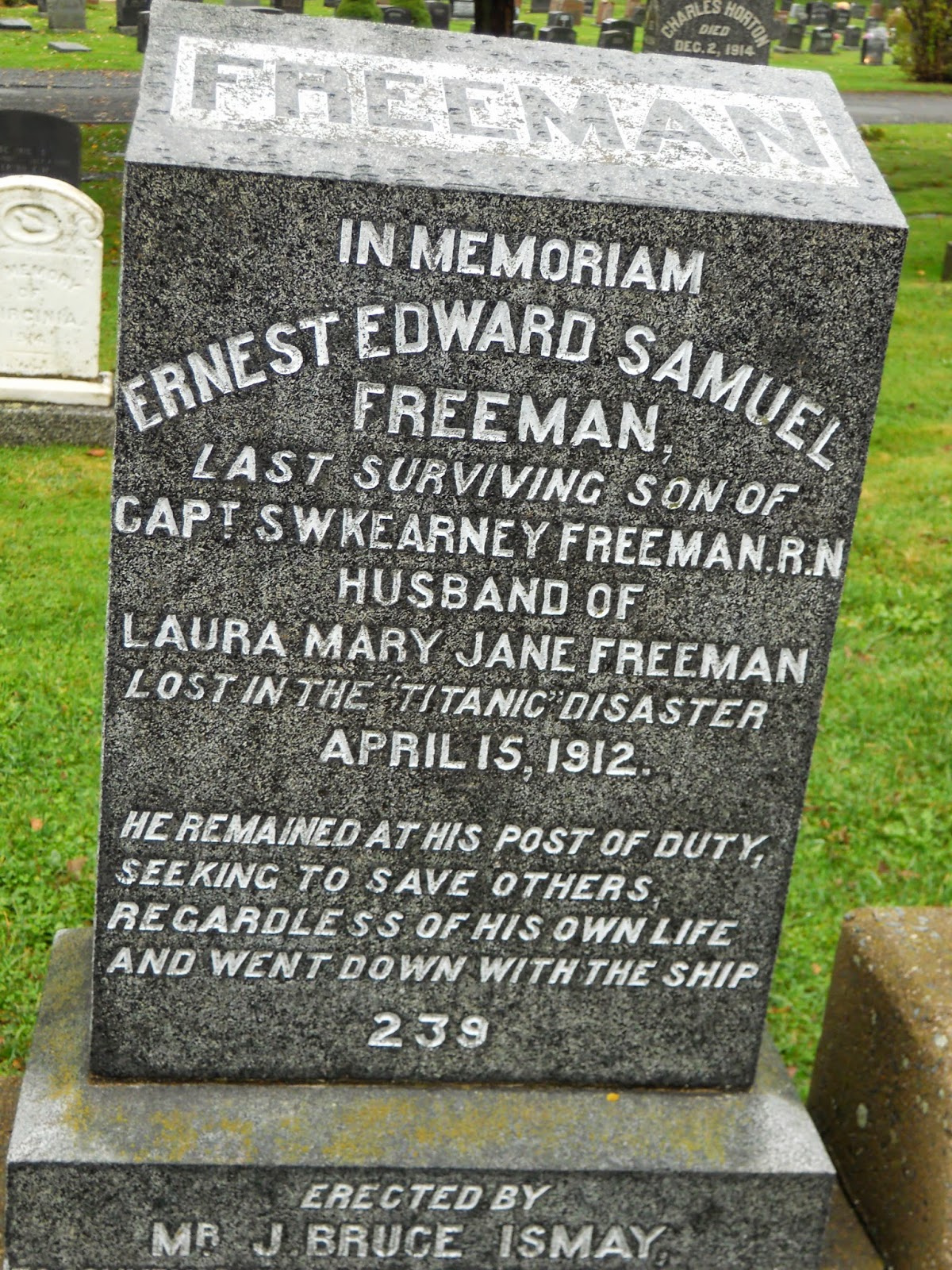 |
Some inscription were so
moving, like this one. |
 |
| And this one, too. |
 |
| But this onemoved me the most. |
 |
| There were so many like this. |
 |
| Just numbers. Heart braking! |
After that, we returned to the ship for eats and socializing and various leisure activities. The following day we went to Bar Harbor, Maine, but that will have to wait for another day, as the next few posts are going to be from Spain and Portugal.
I was never particularly a cruise person before, but this one converted me. Of course, we were iin great company, as well as seeing great sights. And when I get back to posting about Bar Harbor, I'll include a recap with pictures of the great crowd of friends we traveled with.
Meanwhile, I hope you have enjoyed the bits and pieces of this cruise so far. And if you know any special facts about the Titanic, I hope you will share them. That is an event that continues to have such a grip on my conssciousness, and the public's as well.

I'm polishing up a collection of stories to enter in a contest. I should be "back on ship" next week, after I send them out. I certainly miss posting and hearing from you. But, as they say, "First things first."
Till then, happy writing to you.
I'm working on another writing project, so for those of you who are waiting for the next cruise stop (it's coming!) check out Anne R. Allen's wonderful post about writing slow in this speed-driven age HERE: Great insights (and great sanity about writing, I might add.)
Enjoy, and hope to see you soon back on the ship.

Between the holidays, a writing assignment, and cold viruses, I got way behind in my blogging, which was a shame, because I wasn't finished with that cruise in October! And that cruise hasn't been finished with me. It is still one of the most enjoyable trips to share. And so, here we are again, back on the Cruise.
After Quebec City and Prince Edward Island, our next two stops were in Nova Scotia. The first was in Sydney, and this was what was awaiting for people, when we disembarked in the cool morning for the various tours. Some were all day, some were half day, some by bus.
Vicky Kiker and I had chosen the walking tour around Old Sidney, and our tour guide was waiting for us. I am very sorry that once again I didn't get her name. she was very good, and she took us to several old buildings and churches and gave us a little history of the area.
"Nova Scotia" means "New Scotland", and it was renamed such after a number of battles were won and lost and the area had been through several hands. Originally it was part of Acadia, which was a colony of "New France" and included New Brunswick, Prince Edward Island, parts of Quebec and Maine. You can read a little more about it on my other blog,
Victorian Scribbles,
HERE.
It was fascinating to see these old buildings: Jost Heritage House Museum, one of the oldest residential buildings in the city. St. Patrick's Church, the oldest standing Roman Catholic Church in eastern Nova Scotia. Cossit House Museum, where we learned a lot about life in early settlement days, and St. George's Church and Graveyard. St. George is Sydney's oldest building. I didn't get a good picture of St. Patrick's Church, but here are some pictures of the other buildings:
 |
| One of the oldest residences. |
 |
There was a delightful
tour guide inside. |
 |
And our walking tour guide
kept us informed every
step of the way. |
We entered two homes, The Heritage House and the Cossit House Museum. To tell you the truth, when I look at these pictures, I
'm not sure which photos were from which house, but you can see the consistency in how the women dressed. The one on the left told some very witty stories about life way back then. But I enjoyed both tours, and I loved the furniture in those old buildings.  |
The beds actually didn't look
so comfortable. |
 |
| Teller of funny stories. |
 |
| The more sedate housewife. |
 |
| But the dining area had charm. |
 |
| I liked the fireplace. |
 |
Maybe the study? I don't know. It's
bigger than my office space, I know
that. |
 |
Before long, it was time to go
back to our own ship. |
And these model ships were in one of those museums.
 |
| Such workmanship! |
 |
| Every detail so complete. |
 |
But not before I got a picture
of Vicki with our tour guide. |
The tour guide explained her dress: It was a French style for that period. Many maids who came over to the colony were French, and that was the clothing they knew how to sew.
There was still quite a treat to come after we got back to the ship. Our wonderful leader had arranged for everyone to walk over to the Governor's Pub for a delicious lunch. Now, I had every intention of getting pictures of the building, the staff, etc ., like I did the day before when we had the lobster lunch in Prince Edward Island. But all of that was whisked out of my mind by the suprise treat of a lifetime.
The Barra MacNeils, a famous Cape Breton family group of musicians who sing, play, and dance Celtic music, performed at the Governor's Pub that day.
My husband and I adore Celtic music, and was this group fabulous! (We bought two of their CDs.) Before I go any further, let me give you their
official website where you can learn more about them, and here's a
YouTube that lets you hear one of their performances. (Listen to it all the way through, and you'll get a taste of the kind of music we heard.) Then enjoy the pictures below that my husband took as they played at the lunch. (I don't even remember what I ate that day, I was so into the music!)
 |
| Haunting on the fiddle. |
 |
| Great singers, both. |
 |
| Sad song, here! |
 |
| Great keyboard artist. |
 |
Another song to break
your heart. |
 |
Great singing together!
And just before we left . . . Hey! Who is that guy? You know the one I mean . . .
The one next to the guy on the left . . . second from the end . . .
It's our fearless leader!
I hope you enjoyed this little trip to Sydney. Next stop will be Halifax.
On another note, do you like Celtic music? Who is your favorite band
or singer? And if not Celtic, what is your favorite kind of music?
|

Dear Blog Friends,
Right now I'm working on a writing project that has a deadline. Please come back February 1st. Meanwhile, I'll still surf around, reading yours and commenting.
Thanks so much for your patience.
This is a re-post of a post from three years ago about two DVD's, one a favorite opera, and the other a foreign film, both set in the Christmas season, and both set in Europe. The first is an opera set in Belle Epoque France; the latter is a 1914 war story that really is an anti-war story.
The opera was one I've written about before (when Sacramento Opera performed it in Spring of 2010): Puccini's
La Boheme. In this case,
La Boheme, the Movie, stars Anna Netrebko and Rolando Villazon as Mimi and Rodolfo. Both their voices are lush and lyrical, as if the composer wrote the music with them in mind, and their acting brought the story alive. All the cast was good, and the costumes and sets made scenes seem like impressionist paintings in motion. This is such a layered story, each time I hear and see the opera, I have a new appreciation for the breadth of understanding Pucci was able to convey in the music. I marvel how composers achieve on musical scores what I struggle to achieve in just words. I can never can see or hear this opera too many times, and I plan to buy the DVD.
The second movie was
Joyeux Noel, a 2005 film that was nominated for both an Academy Award and a Golden Globe Award for Best Foreign Film. The individual stories highlighted were fictitious, but the over all story is based on a true happening on a Christmas Eve in 1914, in the theater of war, rather than in an opera theater: Scottish, French, and German troops agreed to a cease fire, and put down their weapons to celebrate Christmas Eve, even warning each other of planned shellings the next day and offering refuge in each other's trenches when the shellings occurred. For all three military groups, the only thing that saved troops from being tried for treason was the fact that 200 or so in each case would have to be tried. Instead, all the participants were transferred to other fronts to make sure it wouldn't happen again. It was a remarkable film, and a story I won't forget.
So here it is, the New Year, and the Christmas message hovering still. Best wishes for the coming year, and for a time of peace, when people can be united again in their common humanity.

With the holidays drawing close, I'm offering a second free Kindle download for The Fourth Wish, this time for three days: Sunday, December 15th through Tuesday, December 17th. The last one put the book as #1 in its category. But what made me happiest was the prospect of so many young people being able to read it.
Here is where to go on those dates:This story takes place over the winter holidays. It involves magic and wishes, complex family situations, and I've been told it's very humorous. A good read for both boys and girls, ages 8 to 12.
I hope you will check it out.
Meanwhile, what are some of your favorite titles for readers of that age group?

 |
| Here they are: Clyde and Dawg |
 |
| Author, Lori Mortensen |
I'm taking time out from posts about the cruise to share a charming picture book that would make just the right present for a young child in this gift-giving season:
Cowpoke Clyde and Dirty Dawg, by Lori Mortensen. (It would make a nice library addition for big people, too, if they are dog lovers, as I am.)
The story starts with Cowpoke Clyde cleaning house and innocently deciding the finishing touch would be to give a bath to his dog, who is named, appropriately, Dawg. What happens when Clyde tries is hilarious. I really don't know how much to tell without giving the story away. Let me just say that bathing Dawg is no easy thing. The two leave chaos and commotion in their wake as Dawg gives Clyde the runaround.
Three things about the
writing make this a stellar picture book for me.
1. The tone and "bounce" to this lively story make it one kids will want to read again and again. (Those who are too young to read will want
you to read it aloud again and again.)
2. It's funny. I've read it three times, now, and each time leaves me grinning.
3. The rhyme scans so well! I have great admiration for the ability to write a rhyming stories. They are not easy. Often the rhyme feels a little off, and you feel a writer got away with it because the story was so good. Well, this story is "so good," and the rhyming is too!
As for the
illustrations: With acrylics and colored pencils, Michael Allen Austin has made Dawg into the most lovable mutt you could find—and the other animals on the ranch are pretty captivating, too. Cowpoke Clyde is pawstively endearing.
School Library Journal has calledthis book, "A first purchase for most libraries."
Two other rhyming picture books by Lori Mortensen are:
In the Trees, Honey Bees, that has won all kinds of awards, as well as the award-winning
Cindy Moo. She's also written a non-rhyming biography about Léon Foucault,
Come See the Earth Turn.
 |
| Foucalt's Pendulum' |
 |
| Hey, diddle-diddle. |
 |
Find out about the secret
life of bees. |
You can read my review of
Cindy Moo for
Sacramento Book Review HERE.
And Lori was kind enough to give me an interview
HERE.More information about where and how to buy these books can be found on Lori's
WEBSITE HERE. Visit the site, too, to read more reviews of these books.
What are your favorite picture books? Do you prefer rhyming books or unrhymed stories?

After our first night on the water, we docked at Prince Edward Island, of Anne of Green Gables Fame, and, in two buses, toured the complete island. We had a really good guide, but unfortunately, I didn't think to get her card. She gave us so much information about the island, and made sure we had ample opportunities to get out and see the area firsthand.
 |
| Leaving Quebec City |
 |
Anne, the Island's unforgettable
heroine. (Visit my other blog HERE for
a post about author L.M. Montgomery) |
 |
Our guide on the left and our
bus driver on the right. |
The whole tour took a good part of the day. We toured the island, but stopped for lunch at a unique restaurant in New Glasgow in a building called Prince Edward Island Preserve Company, owned by a beaming man named "Bruce," who greeted us and saw us off afterwards, wearing his traditional Scottish kilt. (About 50% of the islanders claim Scottish ancestry and, adding those of Irish and Welsh heritage, about 80% of the island is of Celtic descent.) |
| Prince Edward Island Preserve Company |
 |
| Bruce, happy to see us come. |
 |
| Bruce, happy to see us go? |
As excitingas it was to tour the island, this stop was quite a highlight, with a fabulous lobster lunch, served by a friendly staff  |
Yes. This guy was on my plate.
And I managed to eat most of it! |
 |
| Friendly staff. |
 |
Dale, showing Rajan and me
how to eat a lobster. |
But it didn't stop there. We had the pleasure of being entertained by Mike Pendergast, aka "The Music Man." Mike sang ditties and folk songs, acting out various parts, while playing his guitar sometimes, and sometimes his accordion. I could have listened to him all afternoon.
 |
| Mike Pendergast |
 |
| "The Music Man" |
 |
A slower song on guitar
|
And, after several song that had everyone's toe tapping and some singalongs, he asked for volunteers. Yes. You guessed it:
 |
| Ernie participated with gusto. |
 |
| He had a serious moment . . . |
 |
| But not for long. |
Now for a few island highlights. Prince Edward island is one of the prettiest places you will ever see. Whenever I read the word "bucolic" in the future, I will think of Prince Edward Island. Among other things, it has the reddest soil you'll ever see, and an unending coastline that loops in and out around its generally crescent shape. Bays and harbors, and fishing villages and farms. It was like stepping into a world long gone -- except it isn't gone. It's scenic beauty continues to exist. We went to Cavendish Bay, Charlottetown, Summerside, and other spots whose names elude me. And with so much to see, I lost track of which was where. Just enjoy them for the way they convey the island atmosphere:
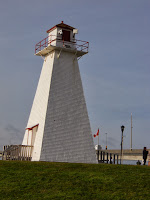 |
| One of many lighthouses |
 |
Along with the fishing, this is an
agricultural place. Potatoes from
PEI are famous. |
 |
Notice the red soil. Very good clay
for ceramics from the area. |
 |
| Made me think of a storybook village. |
 |
| You can see we had good weather! |
 |
| One of many harbors. |
 |
| More surf and red soil. |
 |
These are lobster traps. A lot of the
fishing on PEI is lobster fishing. You
can see why we had such a good lunch. |
 |
Conferation Bridge, connecting PEI
to New Brunswick, is 8 miles long. |
 |
Foxes on the road! My husband was
able to get a couple of photos. What
a beautiful animal! |
 |
There were actually two foxes, but one
walked away while my husband was
taking these pictures. |
And then, last, but not least, the famous house that inspired the popular
Anne of Green Gables series. (You can read more about whose house it really was
HERE.) Anne has been a favorite character of mine, and she's still popular with new readers today.
 |
| The house of Green Gables where it all started. |
Hope you enjoyed this little tour of a fascinating island. Like so many places on this cruise, it was a "one of a kind" experience.

View Next 25 Posts



































































































